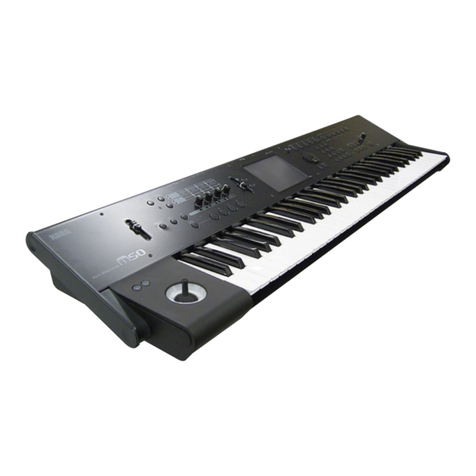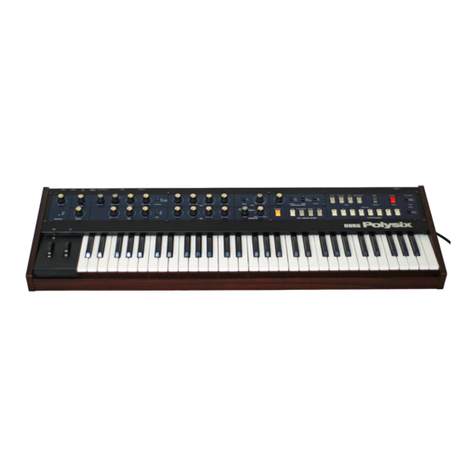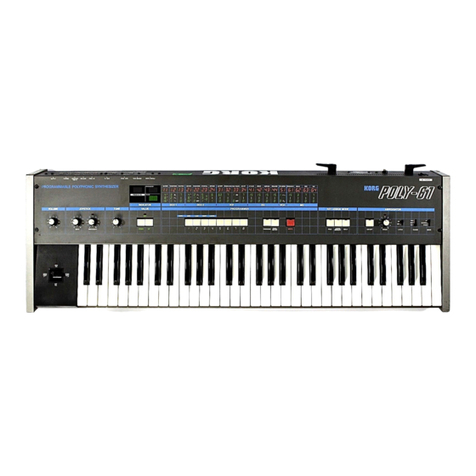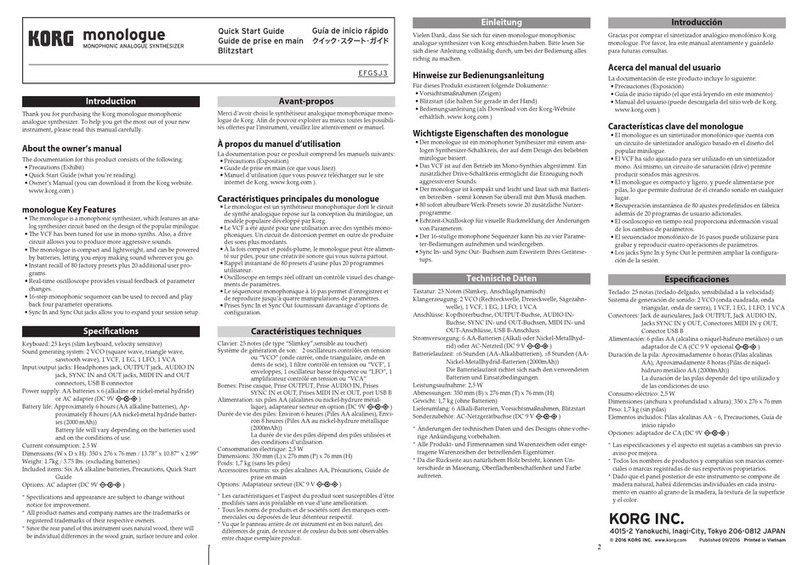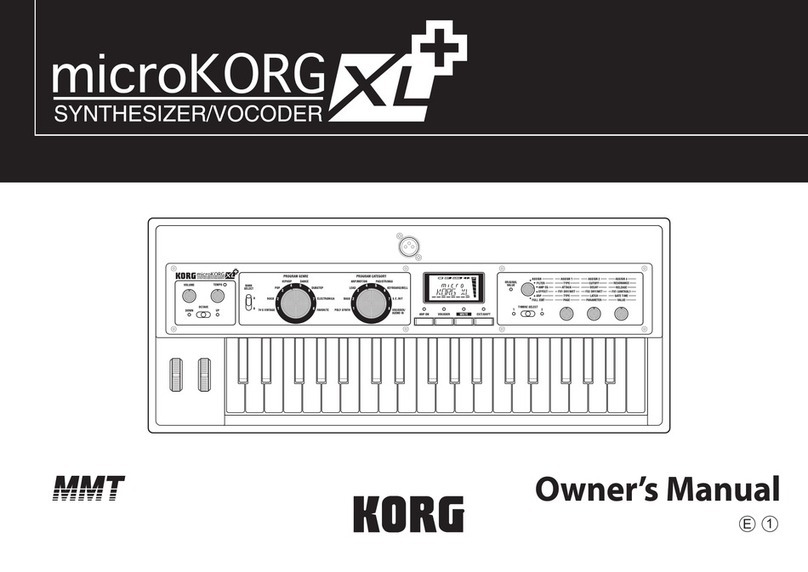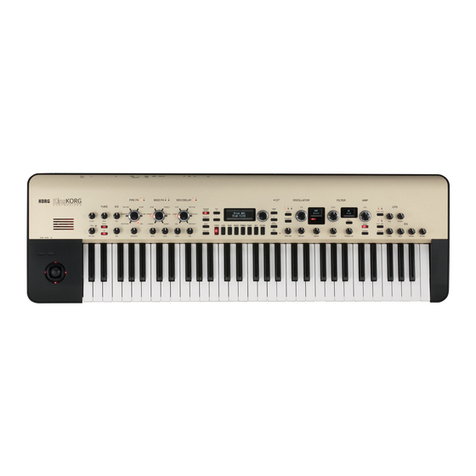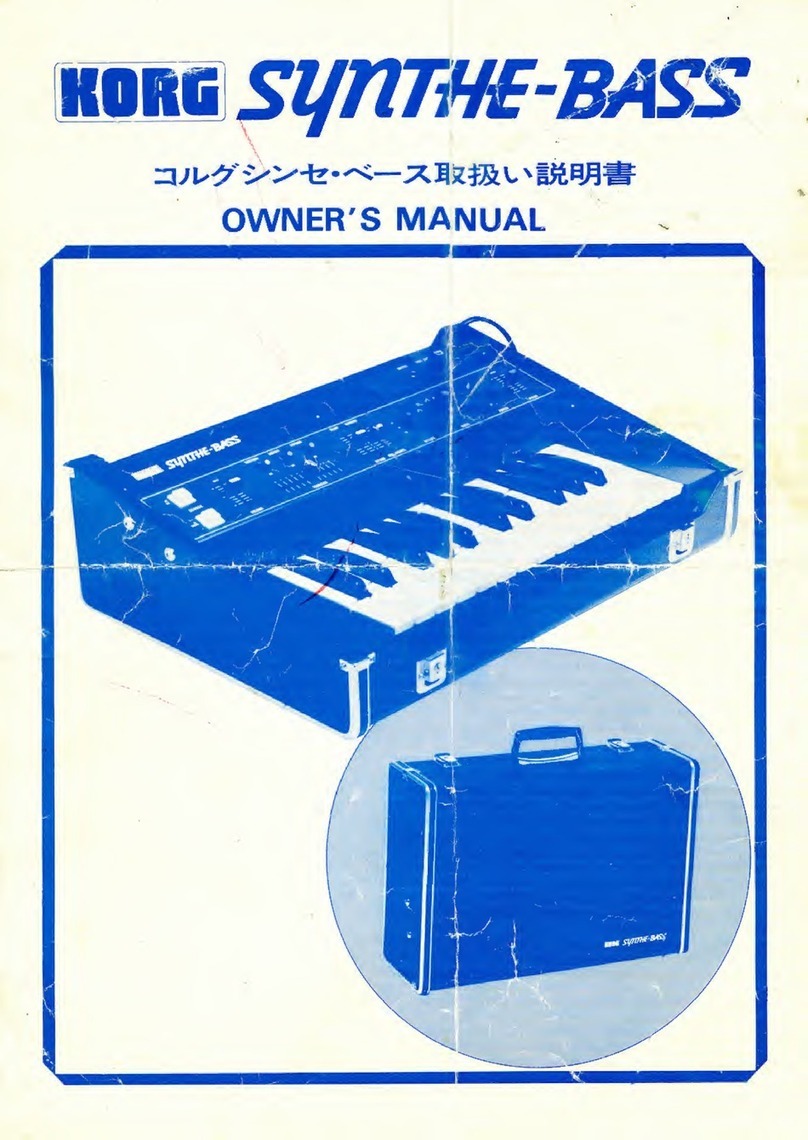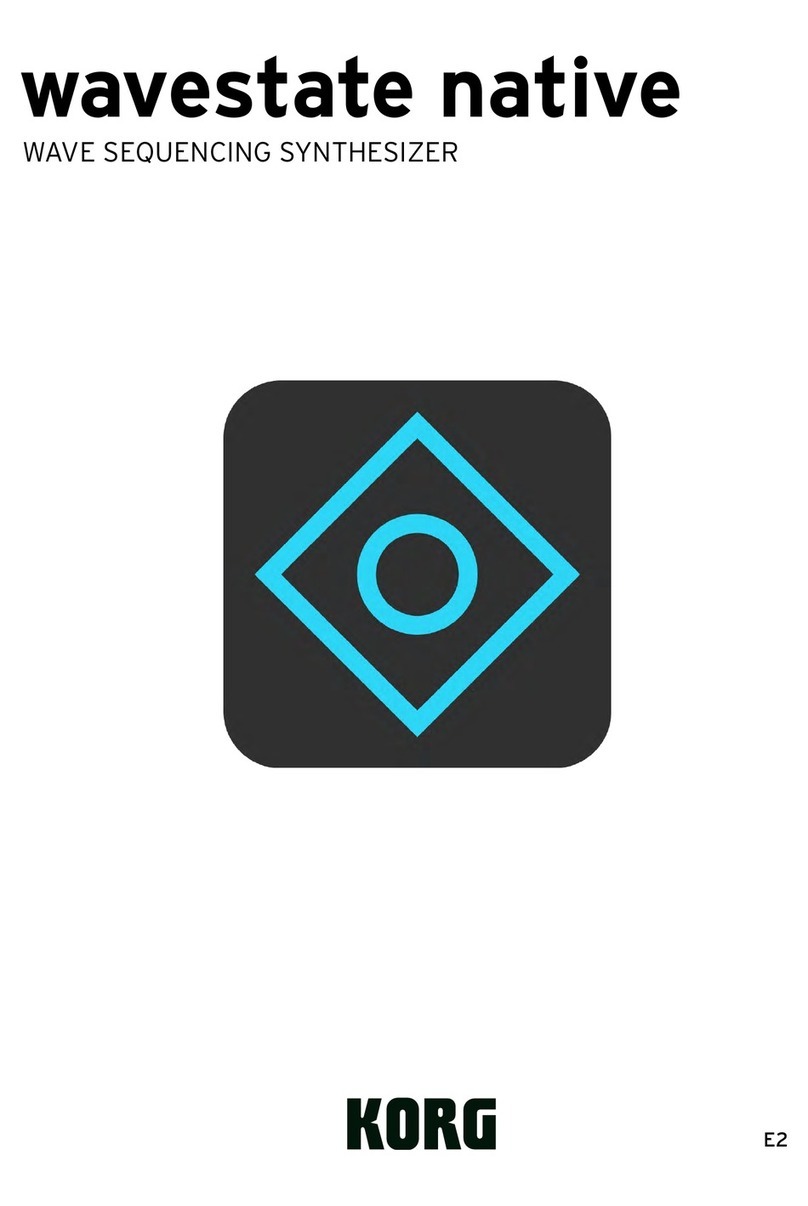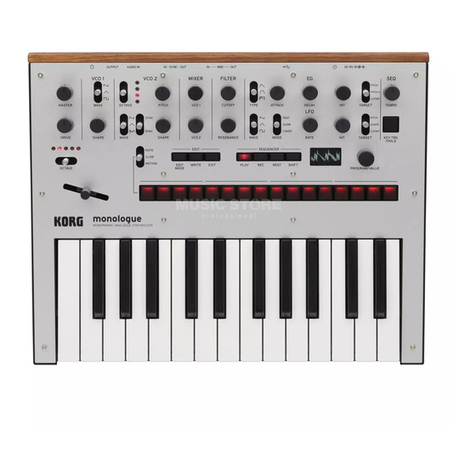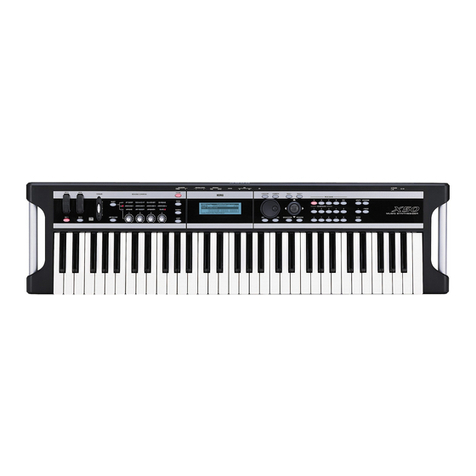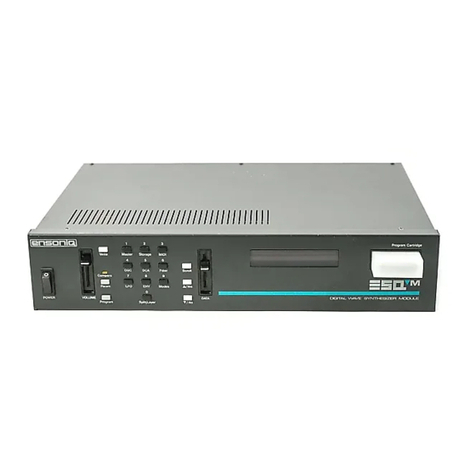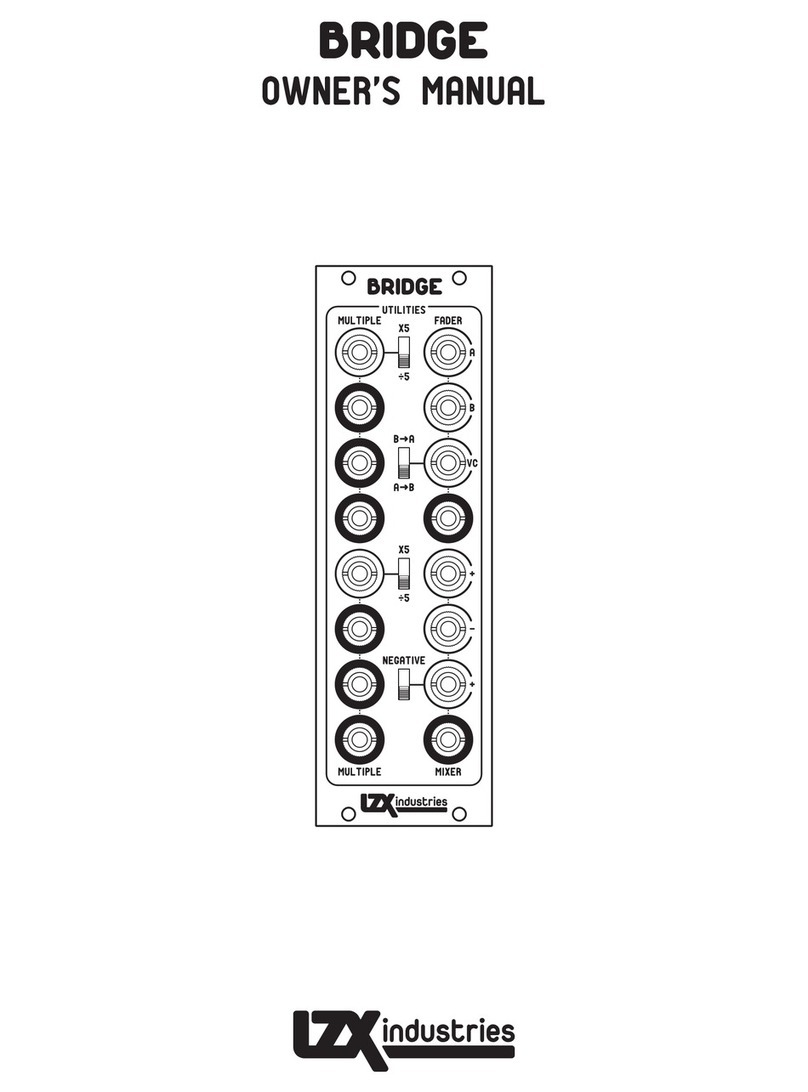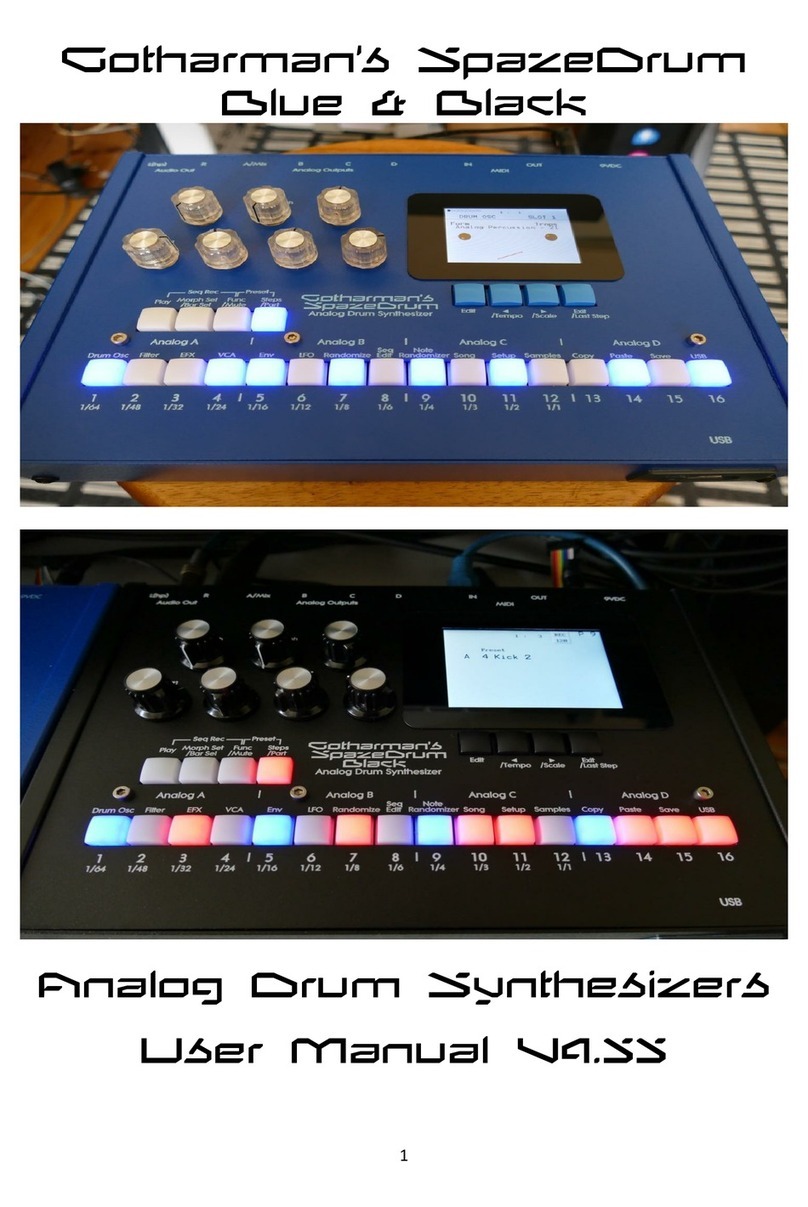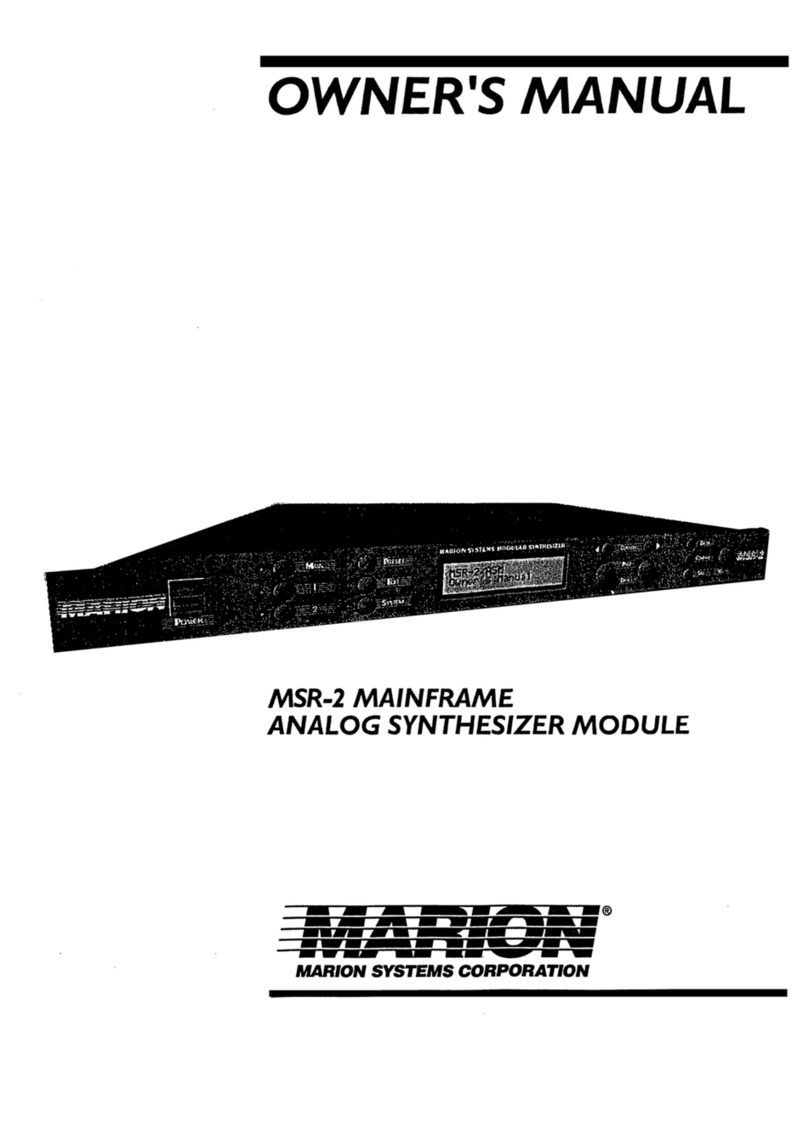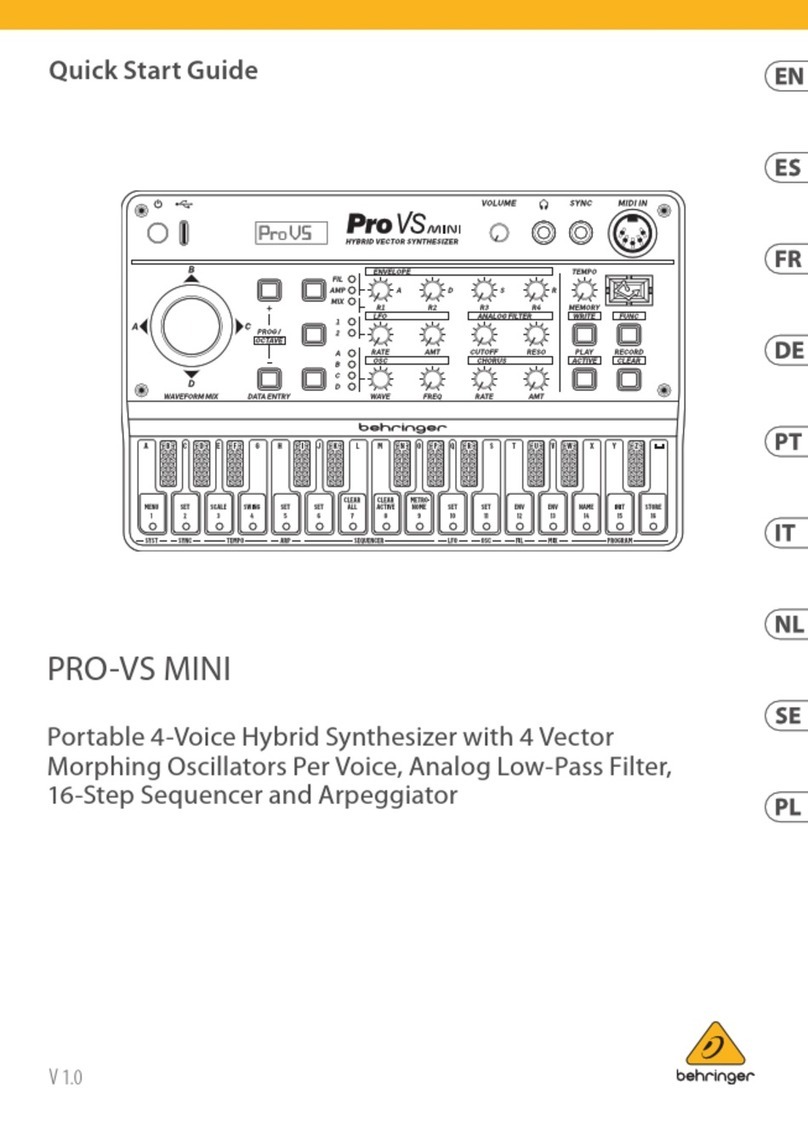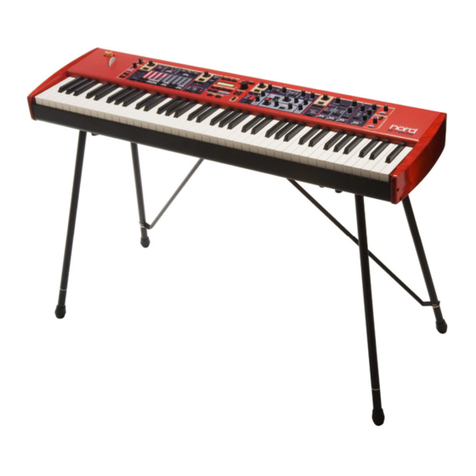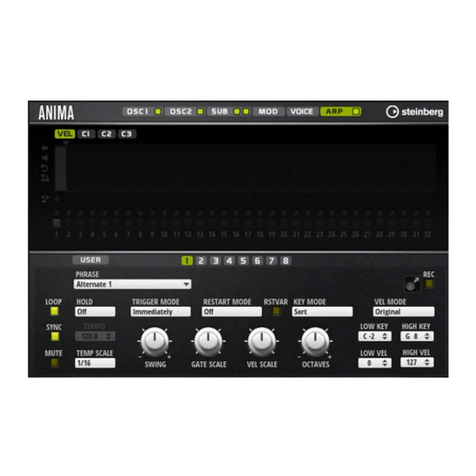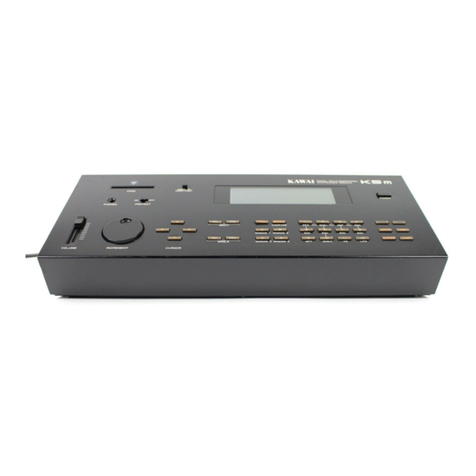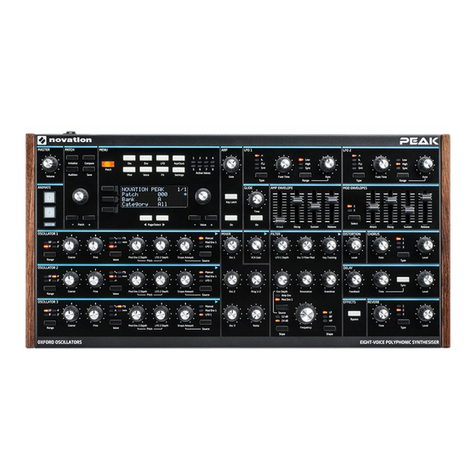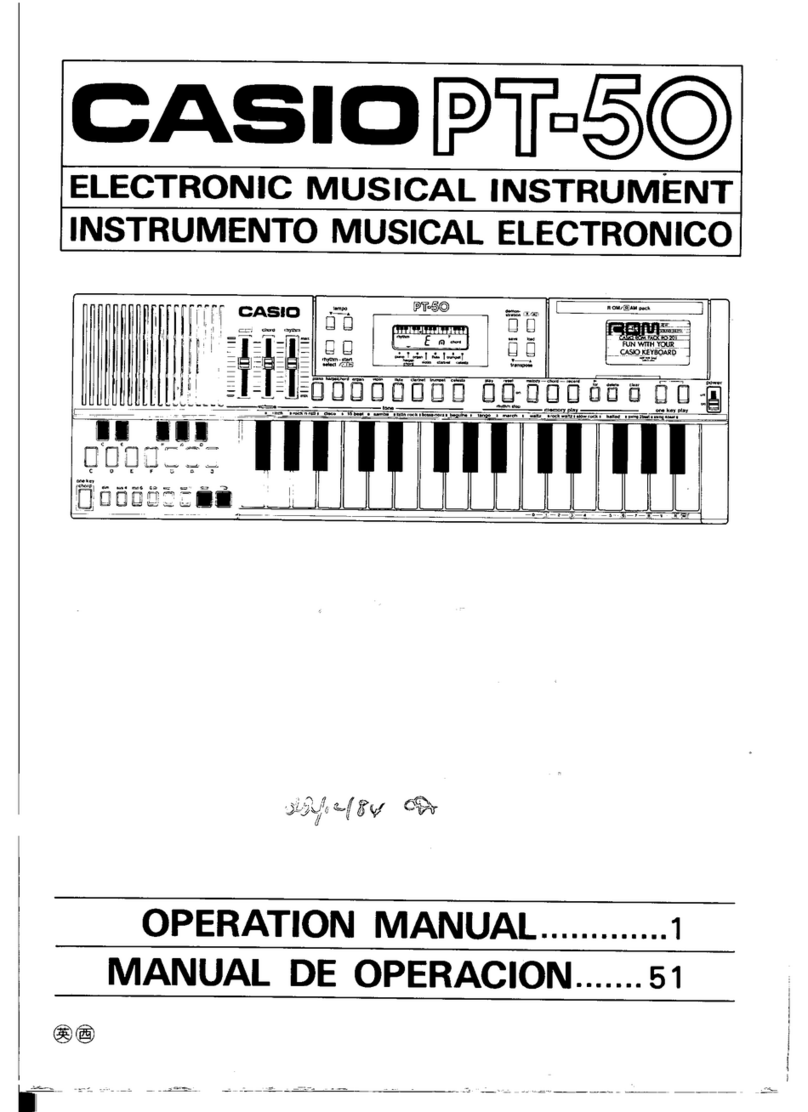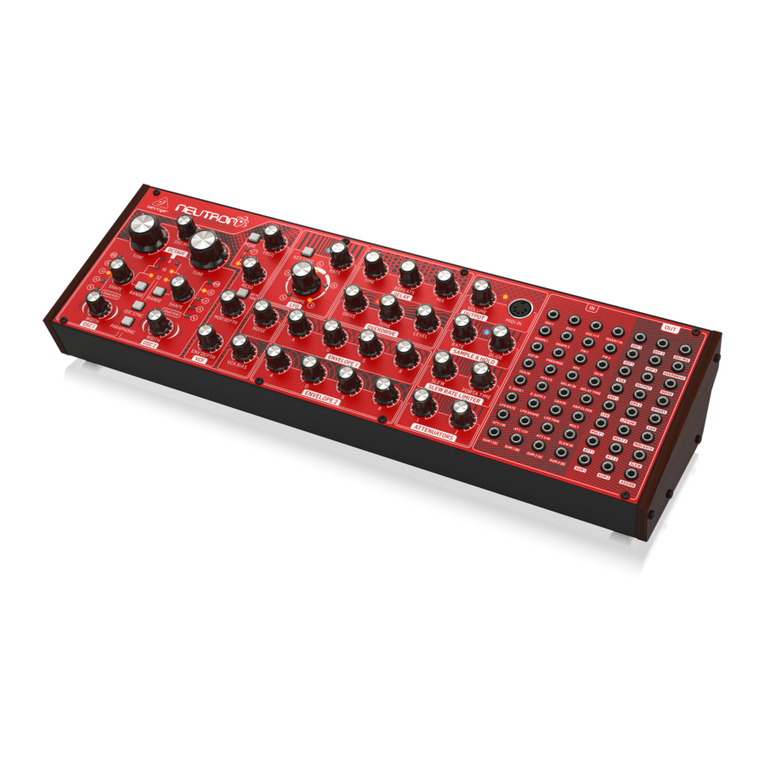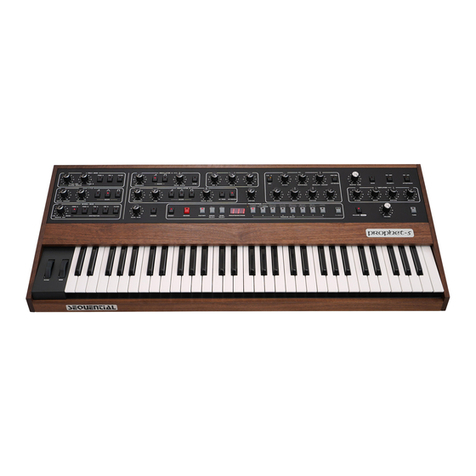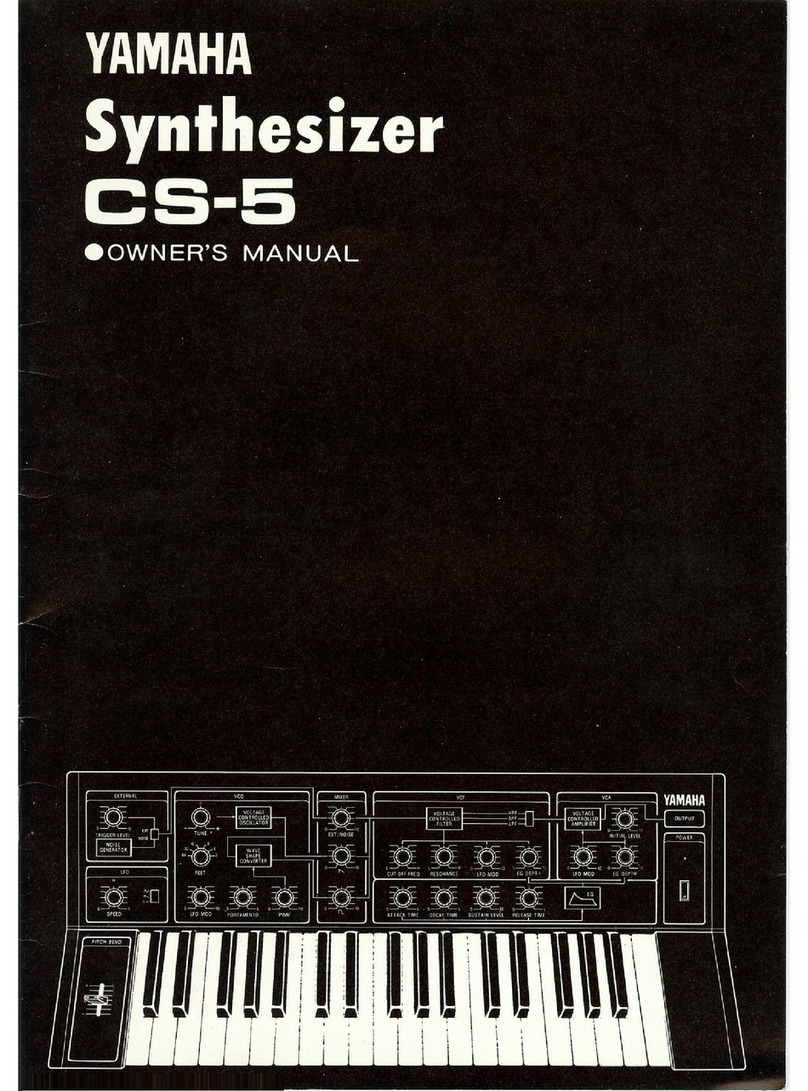Korg ES-50 Lambda User manual

POLYPHONIC ENSEMBLE
POLYPHONISCHEN TASTENINSTRUMENTES
ENSEMBLE POLYPHONIQUE d
korg rLambda
Owner's Manual
Bedienungsanleitung
Mode demploi
SoundI
Revolution!
KORG I
oundT
ionj^
yr1

INTRODUCTION
Congratulations on purchasing the Korg
ES-50 "Lambda" Polyphonic Ensemble. The
ES-50 is an advanced design polyphonic
keyboard instrument which employs the
latest state-of-the-art technology to create
the most versatile and musically playable
keyboard on the market.
There are any number ot "ensemble-
type" instruments available today which offer
aselection of popular and musically useful
voices. But most of these instruments fall
into one of two relatively limited categories:
"Percussive" (e.g. "Electronic Pianos"), or
simple "Sustaining" (e.g. "String
Synthesizers, etc.). To get acombination of
these sounds simultaneously usually
required the use of two or more separate
instruments ...and often some acrobatics
on the performer's part!
But now the new Korg ES-50 "Lambda"
has eliminated these problems by providing
the equivalent of two completely separate
instruments creating atotal of nine different
voices, all played from one keyboard! In
combining two instruments into one, Korg
retained the independent integrity of each
separate instrument. As can be seen in the
Block Diagram, each instrument section
utilizes completely separate polyphonic
Oscillator system Envelope Generators,
filters and Voltage Controlled Amplifiers
(VCA). Unlike many instruments which
purport to deliver "combinations" of voices,
the ES-50 triggers two different Envelope
(Attack) Generators with each key depres-
sion. Since each of these Envelope
Generators operates separate circuitry, total
separation of sound is maintained perfectly.
Your ES-50 Lambda Polyphonic
Ensemble has been designed and
manufactured using the most advanced
technology known. With reasonable care it
will provide years of uncompromising usage
with unsurpassed reliability. To gain the
maximum benefit from all of your ES-50's
features and creative potential, we suggest
you read your Owner's Manual thoroughly
prior to use.
WARNING
To reduce the risk of fire or electric
shock do not expose this appliance to
rain or moisture.
KORG f
POLYPHONIC ENSEMBLE
POLYPHONISCHEN TASTENINSTRUMENTES
ENSEMBLE POLYPHONIQUE
Einleitung
Herzlichen Gluckwunsch zum Kauf des
polyphonischen Tasteninstrumentes Korg
ES-50 "Lamda". Dieses Gerat wurde nach
den neuesten Erkenntnissen der Elektronik
hergestellt und ist wohl ernes der vielseitig-
sten Tasteninstrumente auf dem Markt.
Heute ist bereits eine Vielzahl von
sogenannten Ensemble-Geraten erhaltlich,
die fur vielseitige Musikgestaltung eingesetzt
werden kdnnen. Bei den meisten dieser
Instrumente ist jedoch der Einsatzbereich
beschrankt, d.h. sie kdnnen als Schlaginstru-
mente (z.B. auch Elektro-Piano) Oder als
Halteinstrumente (z.B. Saiten-Synthesizer
usw.) eingestuft werden. Um den Klang
dieser beiden Instrumente-Typen
gemeinsam einsetzen zu kdnnen, sind
normalerweise zwei Oder mehrere separate
Instrumente erforderlich ...und manchmal
mu6 der Musiker schon fast ein Akrobat sein,
um diese Instrumente bedienen zu kdnnen!
Mit dem Korg ES-50 "Lambda" wurden
diese Probleme ein fur allemal geldst; dieses
Gerat entspricht zwei vollstandigen separaten
Instrumenten und ermbglicht bis zu neun
verschiedene Stimmen mit nur einer
Klaviatur. Durch die Kombination von zwei
Instrumenten in einem Gerat wurde ein

Modell geschaffen, bei dem die Eigen-
schaften der einzelnen Instrumenle voll
erhallen bleiben. Wie dem Blockschaltbild
eninommen werden kann, ist jedes Instru-
ment mit einem vollstandig separaten, poly-
phonischen Oszillator-System ausgestattet
und verfugt auch Liber Hullkurvengenerator,
Filter und spannungsgeregelte Verstarker
(VCA). Im Gegensatz zu vielen Instrumenten,
bei welchen eine Kombination von Stimmen
erzeugt wird. schaltet der ES-50 mit jedem
Tastenanschlag zwei verschiedene Hull-
kurvengeneratoren ein. Da jeder dieser
HLillkurvengeneratoren auf einen separaten
Schaltkreis wirkt, wird eine vollstandige
Trennung der erzeugten Klangbilder
gewahrleistet.
Ihr polyphonischer ES-50 "Lambda"
ivurde unter Berocksichtigung der fortschritt-
ichsten Technologien konstruiert und
lergestellt. Bei richtiger Handhabung
jewahrleistet dieses Gerat hohe Zuverlas-
;igkeit und jahrelangen ungestbrten Betrieb.
Jm alle Eigenschaften dieses Gerates voll
lutzen zu kbnnen, sollten Sie die vorliegende
Bedienungsanleitung aufmerksam durch-
esen, bevor Sie den ES-50 in Betrieb
lehmen.
Introduction
Nous vous remercions d'avoir fait I'achat
de cet ensemble polyphonique Korg ES-50
"Lambda". Le ES-50 est un instrument poly-
phonique aclavier extremment perfectionne
parce qu'il integre le summum de la tech-
nique la plus recente et surtout, il possede un
clavier atres haute souplesse d'emploi dont
la musicalite est remarquable par rapport
aux appareils d'autres marques de la m§me
gamme. II existe de nombreux instruments
"du type Ensemble" oftrant un choix
populaire et musical de voix utiles, mais la
plupart de ces instruments tombent auto-
matiquement dans une ou une autre categorie
relativement limitee: Les instruments "a
percussion" (les pianos electroniques, par
exemple) ou tout simplement les instruments
"Sustaining" (ou synthetiseurs acordes, etc).
Pour obtenir une reelle combinaison de ces
divers sons utilises simultanement, il taut
habituellement faire appeal adeux ou a
plusieurs instruments et meme aexiger de
I'executant des acrobaties extraordinaires!
L'apparition de ce nouveau modele Korg
ES-50 vient combler cette lacune parce qu'il
est capable de produire I'equivalent de deux
instruments separes et complets creant un
nombre total de neufs voix differentes, toutes
etant jouees sur un seul clavier! La
combinaison de deux instruments n'a pas
empechee Korg de maintenir une integrite
separee des deux appareils. Comme le
prouve le diagramme synoptique, chaque
section d'instrument utilise des systemes a
oscillateur polyphoniques separes, des
generateurs d'enveloppe, des filtres et des
amplificateurs contrdles en tension (VCA) de
meme nature. Contrairement ade nombreux
instruments qui ont pour but de delivrer des
combinaisons de voix, le ES-50 declenche
deux generateurs d'enveloppe (d'attaque)
differents achaque pression d'une touche.
Etant donne que chaque generateur
d'enveloppe commande un circuit different,
une separation integrale du son peut etre
maintenue ala perfection.
Votre ensemble polyphonique Lambda
ES-50 aete concu et fabrique avec le plus
grand soin et en appliquant la technologie de
pointe dans ce domaine. Un entretien
minimum lui assure de longues annees de
service sans modification aI'usage ni atteinte
asa fiabilite. Pour que le ES-50 offre un
maximum de benefice par ses
caracteristiques et ses potentiels creatifs,
nous vous conseillons de lire entierement ce
mode d'emploi avant de s'en servir.
CONTENTS INHALT SOMMAIRE
BLOCK DIAGRAM 2
MAJOR FEATURES 4
REAR PANEL JACKS 6
CAUTION 7
CONTROL DESCRIPTIONS 9
SPECIFICATIONS 14
SETTING CHARTS 17
1
.
BLOCKSCHALTBILD 1
2. WICHTIGEMERKMALE 5
3. ANSCHLUSSEAUFDER
GERATERUCKSEITE 6
4. VORSICHTSMASSNAHMEN 7
5. BESCHREIBUNG DER REGLER 10
6. FICHE TECHNIQUE 15
7. EINSTELLDIAGRAMME 17
1. DIAGRAMME SYNOPTIQUE 1
2. CARACTERISTIQUES
PRINCIPALES 5
3. PRISES DUPANNEAU ARRIERE 7
4. ATTENTION 7
5. DESCRIPTION DES
COMMANDES 12
6. FICHE TECHNIQUE 16
7. TABLEAUX DE
PROGRAMMATION 17

1. BLOCK DIAGRAM 1. BLOCKSCHALTBILD
Total Tune Pitch Bend
Gesamtstimm/
Tonhbhenanderung
Gamme d'accord totale
Tune A
Stimmung A
Accord A
LFO#2
Tune B
Stimmung B
Accord B
Sustain
Aushalten
Sustain V
I
77!7P
Oscillator System #1
Oszillator-System Nr. 1
Oscillateur 1
">
Decay
Absenkung
Retard
^W^
PERCUSSIVE articulation &
Voicing Circuitry
Schlagzeug-Artikulation und
Stimmen-Schaltkreis
Percussion circuit de
modulation de voix
Oscillator System #2
Oszillator-System Nr. 2
Oscillateur 2
Oscillator System #3
Oszillator-System Nr. 3
Oscillateur 3
Variable ATTACK/RELEASE
Variable ATTACK/RELEASE
Commande Variable ATTACK/
-O
\ /
v
ENSEMBLE Articulation &
Voicing Circuitry
Ensemble-Artikulation und
Stimmen-Schaltkreis
Ensemble circuit de
modulation de voix
T
Attack
Einsatz
Attaque
Release
Freigabe
Chute
To PERCUSSIVE and ENSEMBLE Envelope Generators
Zu den Schlagzug- und Ensemble-Hullkurvengeneratoren
Sur generateurs d'enveloppe d'ensemble et de percussior
Mill
Keyboard
Klaviatur
Clavier

1. DIAGRAMME SYNOPTIQUE
Speed
Schnelle
Vitesse
Tremolo
Tremolo
Tremolo
Voltage Controlled Expression System
Spannungsgeregeltes Ausdrucksystem
Expression reguleeen tension
Speed
Schnelle
Vitesse
RELEASE
1
6
CHORUS PHASE
Chorphase
Phase dechoeur
Expression
Ausdruck
Expression
IVI
TRIG OUT
Trigger-Ausgang
Sortie declenchement
MS-01 Voltage Pedal
MS-01 Spannungsregelpedal
Pedalede tension MS-01
VI
IM,

2. MAJOR FEATURES
JThree Separate Oscillator
Systems.
Three separately tunable and modulated
polyphonic Oscillator systems combine to
produce an unprecedented richness of
sound which no other available instrument
can provide. Most other Ensemble-type
instruments utilize only a single oscillator
system.
2Separte Articulation
per Key.
Two Envelope Generators are con-
nected to each ES-50 key. for atotal of 96.
Combined with individual VCAs (Voltage
Controlled Amplifiers) per note, the ES-50
produces amore natural individual articula-
tion of each note played, instead of the
commonly used "overall" single articula-
tion. Gone are the unnatural "retriggenng"
and "pumping" effects that limit your play-
ing. Instead, the ES-50 delivers the type of
discreet articulation usually found only in
expensive Polyphonic Synthesizers.
*iSeparate "Layering" Effect
for each key.
Layering is apopular effect where two or
more sounds are combined one on top of
another at different attack rates. For ex-
ample, a"Brass" sound followed by "de-
layed" Strings on aslower Attack time is an
often-used and exciting effect. On the Es-
50. the layering effect occurs for each key
depression, thanks to the separate double
Envelope Generator/VCA configuration per
key.
4Authentic, Fully Mixable
Voices
For any Ensemble instrument, the
sounds available are what count. And the
ES-50 has the best sounds available any-
where. Penetrating, rich Electric Piano;
Vibrant Acoustic Piano; Resonant deep
Clav; Beautiful Chime-like Harnomics. Rich
full undistorted Strings; Haunting Human
Chorus; Powerful, Punchy Brass; and
Exciting "B3"-slyle Organ, with "Percus-
sion" effects. And all voices are fully mix-
able, providing endless combinations.
3Extensive Built-in Effects.
In addition to its basic voices, the ES-50
provides awide variety of built-in Effects:
Variable Speed Tremelo on Pianos; Multi-
ple Key Click; Chorus-Phase Effect; Spring-
returned Pitch Bending Joystick; Variable
Attack, Decay and Release controls; "Arti-
culated" Brass Voltage Controlled Filter;
and Externally Controllable, Split "Expres-
sion" facilities.
3Variable Speed Stereo
Chorus-Phase Effect
Adds exciting "ambience" to sounds,
particularly in stereo. You can create ef-
fects from slow "phasing" to authentic
"Leslie" Speaker-type sounds, using the
convenient Joy-stick speed controller.
VProgrammable External
Expression Control System
Through the use of the optional Korg
MS-01 Voltage Pedal (or any other external
control voltage source), the performer can
vary separately the volume of the "Percus-
sive" voices, the "Ensemble" voices, or
both together. This unique ability allows the
user to, for example, control Strings sepa-
rately from the Piano sounds, or any other
desired combination.
•1Lightweight Compact Size.
The ES-50 weighs |ust 7lbs. Its flat top
design is ideal for stacking other key-
boards, particularly Korg's new KP-30
"Sigma" Performance-oriented Mono-
phonic Synthesizer.
iJLarge Scale Integrated
Circuitry Employed.
Thanks to the extensive use of modern
LSI integrated circuitry, the ES-50 is able
to pack the equivalent of 252 oscillators, 97
Envelope Generators, and 576 Voltage
Controlled Amplifiers into its sleek cabinet.

Fool-switch, etc.
FuRschalter usw.
Interrupteur au pied. etc.
I
MS-01 voltage pedal, etc. MS-series synthesizer, etc. Headphone Amps, audio amp. etc.
MS-01 Spannungsregelpedal Synthesizer der MS-Serie Kopfhbrer Verstarker, Tonverstarker usw
usw-usw-Casque d'ecoute Amperes, ampli andio, etc.
Pedale de tension MS-01 ,etc. Synthetiseurs de la serie
MS. etc.
MS-01 MS-50
MS-1050
Amp. etc.
Verstarker usw.
Amp. etc.

3. REAR PANEL JACKS 3. ANSCHLUS
GERATERU
OSUSTAIN INPUT
Connecting the supplied Korg Type "S"
Footswiich. (or any other normally-open,
momentary type switch to this input will
allow the performer to sustain PERCUS-
SIVE voices py foot control . . .comparable
to the function of aPiano's Damper Pedal
The function of the Sustain Footswitch is
overridden py the front panel SUSTAIN'
control, wnicn when activated will sustain
all PERCUSSIVE notes played, regardless
of the status of the footswitch.
EXPRESSION CONTROL
INPUT SWITCH
AControl input and associated "Destina-
tion" Switcr are provided which allow ex-
ternal control vonage sources to vary the
overall volume of the Percussive section.
Ensemble or Doth. When used with the
optional Korg MS-01 Voltage Pedal, the
user has the ability to control the Ensemble
voces searately from the Percussive voices,
TRIGGER OUT
Trigger output is provided, for use with
external synthesizers and other devices.
The Trigger signal is a"Multiple", negative
going "Switch" trigger, which occurs for
every new key depression.
OHEADPHONES (STEREO)
Aseparate output of the STEREO 1, 2
outputs is provided for 8ohm stereo head-
phones.
©STEREO 1,2
Provides separate Stereophonic outputs
as follows:
CHORUS-PHASE off -provides separate
outputs of the Percussive and Ensemble
sections.
CHORUS-PHASE on -The output of the
CHORUS-PHASE returned to the opposite
stereo output from its source, creating full
panoramic effects.
MIX OUT
Provides amixture of all sounds, plus
the output of the CHORUS -PHASE effect
when activated, for use with single channel
reproduction systems.
OSUSTAIN INPUT:
Durch den AnschluR eines Fuftschalters
Korg Typ "S" (oder eines anderen, im
Normalfall geoffneten Schalters) an diesen
Emgang kann der Musiker die PERCUS-
SIVE-Stimmen mittels FuGschalter anhalten
...vergleichbar mit dem Dampfungspeda!
eines Pianos.
Die Funktion des Haltefuflschalters
wird durch den frontseitigen SUSTAIN-
Regler aufgehoben. da dieser Regler bei
Betatigung alle gespielten PERCUSSIVE-
Noten unabhangig von der Stellung des
FuGschalters anhalt.
EXPRESSION CONTROL INPUT
SWITCH:
Ein regelbarer Eingang ermdglicht in
Verbindung mit einem Wahlschalter das
Einstellen der Gesamtlautstarke des
Schlaginstrumente- und des Ensemble-
Abschnittes (Oder beider) anhand einer
externen Steuerspannung. Wird das als
Sonderzubehbr erhaltliche Spannungs-
regelungspedal Korg MS-01 verwendet,
dann konnen die Ensemble-Stimmen
separat von den Schlaginstrumentenklan-
gen geregelt werden.
TRIGGER OUT:
Ein Trigger-Ausgang fur die Verwen-
dung mit externen Synthesizern oder an-
deren Geraten. Das Triggersignal stellt
einen Mehrfach-Schaltausloser dar und
wird mit dem Driicken jeder neuen Taste
erzeugt.
Tuning Stimmen
To tune me Korg Lambda to match the
pitch of other instruments (or reference
pitch). Turn on the Piano tablet alone, and
set the Decay knob to Slow. Then turn the
Total Tune knob to tune to the pitch of the
other instrument or reference pitch.
Next, turn the Tune Aand Bknobs so that
the LEDs above each knob stop flashing.
For this adjustment, it is not necessary to
play any notes on the keyboard. You may
also wish to set the pitch of Tune Aand B
slightly differently to produce interesting
effects
Urn den Korg Lambda auf die Tonhohe
anderer Instrumente zu stimmen. nur die
Klaviatur einschalten und den Verzbge-
rungsknopf auf "Slow" (langsam) stellen.
Danach den Gesamtstimmknopf drehen.
urn dieses Gerat anhand der Bezugston-
hohe eines anderen Instruments zu stim-
men. Anschlief3end die Stimmknopfe Aund
Bdrehen, so daO die Leuchtdioden (LED)
Liber den Knopfen das Blinken einstellen.
Fur diese Einstellung muG keine der Tasten
der Klaviatur angeschlagen werden. Die
Stimmknopfe Aund Bkonnen aber auch
leicht unterschiedlich eingestellt werden,
wenn mteressante Effekte erzielt werden
sollen.

2. WICHTIGE MERKMALE
JDrei separate Oszillator-
Systeme:
Drei separal stimmbare und modulierte
polyphonische Oszillator-Systeme ge-
wahrleisten einen bisher nicht gekannten
Klangumfang. den kein anderes Instrument
zu erzeugen vermag. Die meisten anderen
Ensemble-lnstrumente sind nur mit einem
einzigen Oszillator-System ausgerustet.
3Separate Artikulation
pro Taste:
Zwei Hijllkurvengeneratoren sind an
jede Taste des ES-50 angeschlossen
(insgeamt 96). In Kombination mit indi-
viduellen VCAs (spannungsgeregelten Ver-
starkern) fur jede Note sorgt der ES-50 fur
eine natorliche Artikuulation jeder gespiel-
ten Note, wobei nicht die von anderen In-
strumenten gewohnte "Gesamtartikulation"
eintritt. Und auch das unnatiiliche "Nach-
triggern" und die sogenannten "Pumpen-
effekte" beeintrachtigen nicht mehr die
musikalische Ausdruckskraft. Der ES-50
biirgt fur eine diskrete Artikulation, wie sie
sonst nur in den teuersten polyphonischen
Synthesizern anzutreffen ist.
3Separater "Uberlagerungs-
effekt" fift jede Taste:
Als Uberlagerungseffekt bezeic--e-
man die Kombination von zwei Oder me--e-
ren Klangen ubereinander, wobei .e'-
schiedene Anstiegsraten eingehalten war-
den. So wird z.B. haufig ein "Blechkia'c
verwendet, dem ein verzogerter Saite-""
mit einer langsameren Anstiegszeit Lce--
lagert wird. Bei Modell ES-50 tritt der Uc-e--
lagerungseffekt mit jedem TastedrucK ein,
da jede Taste mit zwei Hiilkurvengerr-s-
toren und spannungsgeregelten ver-
starkern ausgerustet ist.
4Authentische, voll
mischbare Stimmen:
Bei einem Ensemble-Instrument kommt
es auf den erzeugten Klang an -und der
ES-50 bietet einen Klang, der von keinem
anderen Instrument uberboten wird. Ftaurn-
fullendes Elektropiano, Vibranten eines
akustischen Pianos, die Tiefe eines
Klavieres, saubere Obertone, unverzerrte
Saitenklange, Chorgesange, kraftige Basse
und erregende "B3-ahnliche" Orgelklange
mit Schlagzeugeffekten. Und alle Stimmen
kdnnen beliebig gemischt werden, so dafi
eine Vielzahl von Kombinationen zur Ver-
fugung steht.
3Vielsei tige, eingebaute
Effekte:
Zusatzlich zu den Grundstimmen bietet
der ES-50 eine groGe Auswahl an einge-
bauten Effekten: Veranderliches Tempo
mit Tremolo auf Klavieren, Einrasten
mehrerer Tasten, Chorphaseneffekt,
Steuerkniippel fur Tonhohenanderungen
(Einschleifen), veranderliche Anstiegszeit,
Ausschwing- und Freigaberegler, "artiku-
lierte" spannungsgeregelte Filter und ex-
tern geregelte "Ausdruck"-Einrichtungen.
3Regelbarer Stereo-
Chorphaseneffekt:
Sorgt fiir erregenden Stereo-Klang rn t
besonderer Klangfarbe. Sie kdnnen caoe
mit Hilfe eines Steuerknuppels das Te~::
vielseitig regeln.
VProgrammierbares,
externes Ausdrucksregel-
system:
Unter Verwendung des als Sonder-
zubehor erhaltlichen Spannungsregel-
pedals Korg MS-01 (oder einer anderen
externen Spannungsregelung) kann der
Musiker die Lautstarke der Schlagzeug-
Klange und der Ensemble-Klange getrennt
oder gemeinsam regeln. Dieses ein-
zigartige Merkmal ermoglicht es zum
Beispie, die Saiten- separat von den Piano-
klangen (oder jede beliebige Kombination)
einzustellen.
iJKompakte, leichte
Ausfii fining:
Modell ES-50 wiegt nur 3,2 kg; die
flache Oberseite ermoglicht das Abstellen
von zusatzlichen Klaviaturen, wie z.B. des
monophonen Synthesizers Korg KP-30
"Sigma".
iiGroBintegrierte
Schaltkreise:
Dank der Verwendung von LSl-Sc='-
kreisen nimmt der ES-50 trotz seiner •:--
pakten Ausfuhrung 252 Oszillatoren. 97
Hijllkurvengeneratoren und 576 span-
nungsgeregelte Verstarker auf.

2. CARACTERISTIQUES PRINCIPALES
JEnsemble de trois
oscillateurs separes.
Trois oscillateurs polyphoniques
separes, modules el accordables peuvent
se combiner pour produire une richesse
acouslique sans precedent et qu'aucun
instrument de musique ne peut produire.
La plupart des instruments du type aen-
semble utilisent uniquement un systeme a
oscillateur unique.
4Voix entierement
melangeables et
absolument authentiques
Pour tout instrument d'ensemble, les
sons produits sont la seule chose valable.
Dans le cas du ES-50, il est capable de
delivrer les meilleurs sons atout moment.
Un riche piano electrique, un piano
acoustique vibrant, un clavecin profond et
resonnant, de splendides acoustiques
comparables acelles d'un carillon, des
cordes riches et parfaitement tenus, des
choeurs melodieux, des cuivres puissants,
un orgue suprenant "B3" et des effets de
percussion. Sans compter toutes les voix
qui sont entierement melangeables dont le
nombre de combinaisons est infini.
VSysteme de commande
d'expression
exterieure programmable
En utilisant le modele Korg MS-01 op-
tionnel apedale de commande de tension
(ou tout autre sCfurce de commande ex-
terieure de tension), I'executant peut taire
varier separement le volume des voix a
"percussion", des voix d'ensemble, ou les
deux. Cette conception unique en son
genre permit aI'utilisateur de I'appareil de
controler separement les sons d'un piano
ou tout autre combinaison sonore. pour ne
citerqu'unexemple.
2Prononciation separee
par louche
Deux generateurs d'enveloppe sont
relies achaque louche du ES-50 ce qui
produit un nombre total de 96. Une com-
binaison avec des amplificateurs com-
mandes en tension (VCA) par note permet
au ES-50 de produire des prononciations
individuelles encore plus naturelle pour
chaque note jouee ala place de la pro-
nonciation unique "generale". Les effets de
"redecienchement" et de "pompage" qui
limitent I'execution el qui ne sont pas
naturels sont alors supprimes. Ala place, le
ES-50 delivre une prononciation de type
discret comparable acelle delivree
habituellement par des synthetiseurs poly-
phoniques onereux.
3Effets incorpores
prolonges
En plus des voix fondamentales, le ES-
50 est capable de produire une grande
variete d'effets: tremolo sur piano avitesse
variable, divers declic de touche, des effets
en phase de choeur, manche de courbure
de hauteur du son aretour et ressort, di-
verses commandes d'attaque. de retard et
de chute, filtre regule en tension de cuivre
"prononces" et plusieurs dispositifs ex-
pression "fendue" acommande exterieure.
iJUn instrument compact
et leger
Le ES-50 ne pese que 7livres. II est
extra plat et convient parfaitement pour etre
empiler sur d'autres claviers, notamment
sur le synthetiseur manophonique aper-
formances orientees "Sigma" Korg KP-30.
3Effet de couche separe
pour chaque touche
L'effet de couche est un effet classique
ou deux ou plus de deux sons sont com-
bines I'un sur I'autre adifferents reglages
d'attaque. Par exemple, un son de cuivre
suivi par des cordes retardes sur une duree
d'attaque lente est un effet sensationnel
couramment employe. Sur le ES-50, l'ef-
fet de couche se produit achaque pression
de touche grace ala double configuration
separee d'un generateur d'enveloppe et
d'un amplificateur regule en tension.
3Effet en phase de choeur
stereo avitesse variable
Ajoutez une ambiance particuliere aux
sons, notamment en stereo. Vous pouvez
creer des effets allant du phasing aun
authentique son "Leslie" delivre par une
enceinte acoustique en utilisant le contrdle
de vitesse amanche.
iJMontage aintegration
agrande echelle
L'adoption d'un montage aintegration a
grande echelle pour le ES-50 apermis de
rassembler 252 oscillateurs, 97 genera-
teurs d'enveloppe et 576 amplificateurs
commandes par variation de tension dans
un coffret d'une rare elegance.

4. CAUTION
•Always be sure to use the correct AC
power supply voltage.
•Never plug anything other than standard
phone plugs into the input and output jacks.
•Do not use solvents, such as paint thin-
ner, to clean the unit.
•If this unit fails to operate correctly, con-
tact the retailer where you purchased the
unit, or contact the Korg service depart-
ment.
4. VORSICHTSMASSNAHMEN
•Immer darauf achten, dal3 die Netzspan-
nung der Nennspannung des Gerates
entspricht.
•Nur normale Phonostecker an die Ein-
und Ausgangsbuchsen anschlieBen.
•Fur das Reinigen des Gerates durfen
keine Losungsmittel (z.B. Farbverdiinner
usw.) verwendet werden.
•Falls das Gerat nicht richtig arbeitet,
wenden Sie sich bitte an Ihren Fachhandler
Oder an den Korg Kundendienst.
4. ATTENTION
•Faire en sorte de toujours utiliser la ten-
sion d'alimentation secteur appropriee.
•Ne jamais raccorder d'autres fiches que
des fiches phono standards dans les prises
d'entree et de sortie.
•Ne pas utiliser de solvants tels que des
diluants apeinture pour nettoyer I'appareil.
•Si I'appareil ne fonctionne pas comme
prevu. faire appel au revendeur qui vous
avendu I'appareil ou signaler le fait aun
service de depannage Korg.


5. CONTROL DESCRIPTIONS
OPitch Bend/Chorus-Phase Joystick
Left-right movement of the Joystick
varies the tuning of the entire instrument
over a range of ±2 semitones. The Joy-
stick is "spring-returned" to its middle in-
tune position, for convenient, momentary
"pitch bending" effects.
Forward-backwards movement of the
Joystick varies the "rate" of the Chorus-
Phase effect (which is activated using the
Chorus-Phase Selector Switches). Speed
can be varied from aslow "Flanging"-type
effect to that of arotating "Leslie"-type
speaker. The Joystick remains in whatever
forward-backward position is set by the
performer.
©Chorus-Phase Selector Switches.
These switches determine which instru-
ment voices (Percussive/Ensemble) will be
processed through the Chorus-Phase
system. Depressing abutton activates the
effect for the designated section and lights
the corresponding LED indicator; depress-
ing it again cancels the effect for that sec-
tion.
When the STEREO OUTPUTS 1&2are
being utilized, each section's processed
signal is returned to the opposite output
from the unprocessed signal, creating en-
hanced stereo effects.
Oscillator Tune Controls.
These controls vary the individual and
overall tuning of the ES-50's three oscillator
systems:
Total Tune: Varies overall tuning by ±2
semitones.
Tune A/B: Varies individual tuning of two
of the three oscillator systems by ±2 semi-
tones. This arrangement allows the user to
create extra "richness" by slightly de-tun-
ing the three oscillators from each other.
Tuning indicators: Twin LED lights pro-
vide visual indication of the amount of
"detuning" for oscillators "A" and "B". The
LEDs stop blinking when the designated
oscillator is in tune with the Master. (NOTE:
STRINGS I, STRINGS II and CHORUS
voices must be "Off" for visual tuning.)
For best results, tune the three oscillator
systems slightly apart from each other,
such that the LEDs blink approximately 1-2
times asecond.
o
I
o
r_ii a
Oscillator
System »i
Oscillator
System a2
Oscillator
System *3
OAccent Controls
Brass Fc: Varies the Cut-of Frequen-
cy (Fc) of the Voltage Controlled Filter
(VCF) associated with the Ensemble Sec-
tion's BRASS Voice. Rotating this control
from its extreme left to its extreme right pro-
duces timbres from "French Horn" to
"Trumpet".
ELECTRIC PIANO Key Click: Varies
amount of apercussive "click" sound
which occurs for each key depression on
the ELECTRIC PIANO Voice. This effect
increases "penetration" of sounds, par-
ticularly in live performance situations, and
can produce a"mallet" effect when creat-
ing "Vibes" sounds.
Tone Controls
Rotary tone controls are provided for
each section (Percussive, Ensemble) to
allow variations in tonal quality as desired.
These controls are designed as "Boost
and Cut" type, for increased effectiveness.
Volume Controls
Individual easy-to-use slider-type
volume controls are provided for each se-
ctions output to facilitate overall control of
the ES-50's output level and balance.
If the optional Korg MS -01 Control
Voltage Pedal is being used via the EX-
PRESSION control jack to vary the ES-50's
volume levels, the front panel controls will
determine the maximum level achievable
bytheMS-01 Pedal.
OOctave UP:
Raises the entire instrument's tuning by
one octave. In effect provides afive octave
span to PERCUSSIVE voices, and asix
octave span to ENSEMBLE voices.

©PERCUSSIVE SECTION
•Voices
ELECTRIC PIANO: The sounds of awide
variety of Electric Pianos are created. The
Percussive TONE control will vary this
voice from a"Vibes" to ametallic "Reed"
effect. The use of the ELECTRIC PIANO
KEY CLICK control will enhance the "per-
cussiveness" of the Voice. ELECTRIC
PIANO can also be combined with the
HARMONICS voice, for an effective
"Vibes" Piano effect.
PIANO: Creates the sounds of Acoustic/
Electric Pianos. Use this voice with the
Chorus- Phase System at slow speeds to
produce a"multiple piano string" effect,
which is particularly impressive in stereo.
CLAV: Renders afunky "struck string" ef-
fect, popular in many styles or current
music.
HARMONICS: Creates "Bell-Chime-like"
effects 3octaves above fundamental tones.
Useful for "Celeste" effects, or to add bril-
liance and clarity to other voices.
•Effects
SUSTAIN: Cancels "damping" of notes
which normally occurs following key re-
lease. The effect is the same as continuous-
ly holding down the Damper pedal on a
piano.
This switch overrides the function of any
sustain footswitch connected to ES-50 rear
panel "SUSTAIN" jack.
Tremelo On/Off -Speed: Processes all
Percussive Voices through avariable
speed "Tremelo" (Amplitude Modulation)
effect. The speed of the effect is varied by
the TREMELO SPEED control from ap-
proximately 0.5 -8Hz.
ENSEMBLE SECTION
These voices utilize up to three separate
oscillator systems to create rich orchestral
backgrounds.
•Voices
BRASS: This voice uses adouble oscilla-
tor sound processed through an "articu-
lated" Voltage Controlled Filter (VCF), for
enhanced realism. The VCF's Cutoff Fre-
quency is front-panel variable (BRASS Fc),
to produce awide range of "Horn" sounds.
ORGAN: ARock/Jazz Organ effect is
created using multiple oscillators and
multiple octaves. It is best used with the
CHORUS-PHASE effect, which can create
variable speed "Rotating Speaker" effects.
Organ "Percussion" effects can be
created by combining ORGAN with the
HARMONICS Voice in the PERCUSSIVE
section. The Percussive VOLUME and
DECAY controls act as Organ Percussion
"Volume" and "Length" controls, respec-
tively.
CHORUS: Creates the sound of alarge
group of vocalists. This unusual voice is
best used with the Variable ATTACK and
RELEASE controls, and with the CHORUS-
PHASE system at slow speeds for in-
creased "ambience".
STRING I, II: The sounds of an ensemble
of Violins, Violas and Cellos are created by
these voices. STRING Iis alower 16' voice;
STRING II is an octave higher (8'), and
can be combined with STRING Ifor an
expansive orchestral effect. The CHORUS-
PHASE system can create stunning
"panoramic" effects of alarge concert hall.
The richness of the sound can also be in-
creased by slight "detuning" of the oscil-
lators using the TUNE A&B controls.
The use of the Variable ATTACK and
RELEASE controls offers many dramatic
effects, including "delayed" strings and
"split keyboard" effects (see Variable AT-
TACK/RELEASE). When combining String
Voices with aPiano Voice, the use of a
moderate amount of variable ATTACK will
produce greatly enhanced realism.
•Effects
Vibrato Off: Eliminates Frequency Modula-
tion (Vibrato) effects applied to STRING
and CHORUS voices, thus adding a
"glassy", unmodulated sound to these
voices. The judicious use of the TUNE A&
Bcontrols will create variable amounts of
"beating" effects between the three oscil-
lators.
Variable ATTACK/RELEASE: With the
switch in the normal position, the Attack and
Release times (beginning and end of each
note played) are preset for fast articulation.
With the switch activated, the Attack and
Release times can be separately varied
over awide range by their respective con-
trols.
Exciting "Delayed" String/Chorus ef-
fects are created by setting the Attack con-
trol at or near its maximum. Used in con-
junction with a"Piano" Voice, every key
depression will produce the piano note fol-
lowed by the slower String note. If the key
is released quickly, the String note will not
occur. This powerful feature allows selec-
tive expression of String versus Piano
sounds, depending on how the keyboard is
played. Notes played quickly ("staccato")
will produce Piano sounds only; notes held
down will produce an initial Piano note fol-
lowed by asustained String note. With a
little practice, you will be able to create
"Split Keyboard" effects of sustained String
sounds combined with percussive Piano
effects ...from one keyboard!
Utilizing alonger Release Time via the
Variable Release control gives arealistic
concert hall "ambience", since each note is
sustained independently.
©POWER
Applies AC power to the ES-50 and
lights the Power On indicator.

5. BESCHREIBUNG DER REGLER
OSteuerkniippel fiir Tonhohen-
anderung Chorphase:
Diesen Steuerknuppel nach rechts Oder
links bewegen, urn das gesamte Instrument
uber einen Bereich von ±2 Halbtonen zu
stimmen. Der Steuerknuppel wird durch
Federkraft in seine Mittelstellung zuruck-
gebracht, wenn momentane Tonhohen-
anderungen erfolgen sollen.
Wird der Steuerknuppel in Vorwarts/
Riickwartsrichtung bewegt, dann andert
sich die "Rate" des Chorphaseneffektes
(der durch die Chorphasen-Wahlschalter
eingeleitet wird). Das Tempo kann von
einem langsamen Randeffekt bis zu dem
eines drehenden "Leslie"-Lautsprechers
geandert werden. Der Steuerknuppel ver-
bleibt in der vom Musiker eingestellten
Position in der Vorwarts/Ruckwartsrichtung.
©Chorphasen-Wahlschalter:
Diese Schalter bestimmen, welche In-
strumentenklange (Schlaginstrumente/En-
sembleinstrumente) durch das Chor-
phasensystem verarbeitet werden. Durch
das Drucken eines Knopfes wird der Effekt
fur den gewunschten Abschnitt eingeleitet,
wobei die entsprechende LED-Anzeige
aufleuchtet. Wird die Taste nochmals
gedruckt, dann wird der Effekt aufgehoben.
Werden die STEREO-Ausgange 1&2
verwendet, dann werden die verarbeiteten
Signale der einzelnen Abschnitte seiten-
verkehrt gegeniiber dem unverarbeiteten
Signal an die Ausgange angelegt, wodurch
ein betonter Stereo- Effekt entsteht.
Oszillator-Stimmregler:
Mit diesen Reglern werden die drei
Oszillatorsysteme der ES-50 gestimmt.
TOTAL TUNE: Die Gesamttonhohe kann
im Bereich von ±2 Halbtonen gestimmt
werden.
TUNE A/B: Zwei oder drei der Oszillator-
systeme werden individuell urn bis zu ±2
Halbtone gestimmt, Der Musiker kann
damit einen reichen Klang erzielen, indem
die Tonhdhe der drei Oszillatoren jeweils
geringfugig gegeneinander verstimmt wird.
TUNING INDICATORS: Doppelte LED-
Anzeigelampen gewahrleisten visuelle
Kontrolle uber das "Verstimmen" der Oszil-
latoren "A" und "B". Die Leuchtdioden
stellen das Blinken ein, wenn der ent-
sprechende Oszillator genau auf die Ton-
hdhe des Bezugsoszillators gestimmt ist.
(Hinweis: STRINGS I, STRINGS II und
CHORUS Stimmen muzzen fur das visuelle
Stimmen abgeschaltetsein.)
Urn optimale Ergebnisse zu erzielen, die
drei Oszillatorsysteme etwas gegenein-
ander verstimmen, so da6 die lichtemit-
tierenden Dioden (LED) ungefahr ein- bis
zweimal pro Sekunde blinken.
Oo
TOTAL TUNE
I_j{ i.
Oszitiator-
Sysiem Nr. 1
Osztllaior-
Syslem Nr. 2
Oszillator-
System Nr. 3
OTonfallregler
Brass Fc: Andert die Grenzfrequenz (Fc)
des spannungsgeregelten Filters (VCF),
das der BRASS-Stimme des Ensemble-
Abschnittes zugeordnet ist. Wird dieser
Regler von ganz links nach ganz rechts
gedreht, so werden von einem Horn bis zu
einer Trompete reichende Klangfarben
erzeugt.
ELECTRIC PIANO Tastenklick: Andert
die Starke des Anschlages bei Betatigung
der einzelnen Tasten fur den ELECTRIC
PIANO Klang. Dieser Effekt fuhrt zu einer
groBeren Durchdringung des Klanges,
besonders bei Live-Darbietungen, und
kann "Schlagholzeffekte" erzeugen.
©Klangregler (TONE):
FLir jeden Abschnitt (Schlaginstrumente,
Ensemble) sind Drehknopfe vorgesehen,
die ein Einstellen der gewunschten Klang-
farbe ermoglichen. Diese Regler sind als
"Boost-and-Cut"-Steller ausgefuhrt, urn
optimalen Einsatzzu gewahrleisten.
Lautstarkeregler (VOLUME):
Separate Gleitbahn-Lautstarkesteller
ermoglichen optimale Balance und genaue
Einstellung der Ausgange der verschie-
denen Abschnitte des ES-50, urn den Ge-
samtausgang des ES-50 prazise regeln zu
konnen. Wird das als Sonderzubehor
erhaltliche Steuerspannungspedal Korg
MS-01 uber die EXPRESSION-Buchse
verwendet, um die Lautstarkepegel des
ES-50 zu verandern, dann bestimmen die
frontseitigen Regler den mittels Pedal MS-
01 maximal erreichbaren Lautstarkepegel.
OOCTAVE UP:
Hebt die Tonhohe des gesamten In-
strumentes um eine Oktave an. Gewahr-
leistet einen Tonhohenumfang von funf
Oktaven fiir PERCUSSIVE-Stimmen und
sechs Oktaven fur ENSEMBLE-Stimmen

PERCUSSIVE-Abschnitt:
•Stimmen
ELECTRIC PIANO: Die Klange von ver-
schiedenen Elektropianos werden erzeugt.
Der TONE-Regler andert diesen Klang von
einem "Vibes"- bis zu einem metallischen
"2ungen"-Effekt. Die Verwendung des
ELECTRIC PIANO KEY CLICK Reglers
erhoht den Schlageffekt dieses Klanges.
ELECTRIC PIANO kann auch mit der
HARMONIC Stimme kombiniert werden,
urn einen speziellen Pianoeffekt zu erhalten.
PIANO: Erzeugt den Klang eines akusti-
schen/elektrischen Pianos. Diese Stimme
mit dem Chorphasensystem bei geringem
Tempo verwenden, urn Piano-Mehrsaiten-
Effekte zu erzeugen, die besonders bei
Stereo-Betrieb beeindruckend sind.
CLAV: Ein besonderer "Schlagsaiten"-
Effekt, der in moderner Musik verwendet
wird.
HARMONICS: Erzeugt einen Glocken-
effekt drei Oktaven uber dem Grundton.
Wird besonders vorteilhaft fur "Celeste"-
Effekte bzw. fur zusatzliche Brillanz und
Klarheit bei anderen Stimmen verwendet.
•Effekte
SUSTAIN: Die normalerweise nach dem
Freilassen einer Taste auftretende Damp-
fung wird aufgehoben. Der Effekt ist gleich,
wie beim kontinuierlichen Niedertreten des
Dampfungspedals eines Pianos. Dieser
Schalter hat Vorrang uber den an die
Buchse SUSTAIN angeschlossenen
FuBschalter.
TREMELO ON/OFF -SPEED: Verarbeitet
alle Schlaginstrumente-Klange mit einem
"Tremolo"-Effekt (Amplitudenmodulation)
mit regelbarem Tempo. Das Tempo dieses
Effektes wird mittels TREMELO SPEED
Regler in einem Bereich von 0,5 bis 8Hz
einqestellt.
ENSEMBLE-Abschnitt:
Diese Stimmen nutzen bis zu drei
separate Oszillatorsysteme, urn reichen
Orchesterklang als Hintergrund zu erzeu-
gen.
•Stimmen
BRASS: Ein durch ein "artikuliertes" span-
nungsgeregeltes Filter (VCF) verarbeiteter
doppelter Oszillatar-Klang gewahrleistet
verstarkten Realismus. Die VCF-Grenz-
frequenz kann frontseitig (BRASS Fc) ein-
gestellt werden, um einen gro(3en Bereich
von "Horn"-Klangen zu erzeugen.
ORGAN: Ein Rock/Jazz-Orgel-Effekt wird
durch die Verwendung von mehreren
Oszillatoren und mehreren Oktaven er-
zeugt. Wird vorteilhaft mit dem CHORUS-
PHASE Effekt verwendet, um einen "Dreh-
lautsprecher"-Effekt mit veranderlichem
Tempo zu erhalten.
Ein Orgel-Percussion-Effekt kann er-
zeugt werden, indem die ORGAN- mit der
HARMONICS-Stimme im PERCUSSIVE-
Abschnitt verwendet wird. Die VOLUME-
und DECAY-Regler (PERCUSSIVE Ab-
schnitt) dienen zur Einstellung der Laut-
starke und der Tonlange.
CHORUS: Erzeugt den Klang einer groflen
Sangergruppe. Diese Chorstimme wird
vorzugsweise mit den ATTACK- und RE-
LEASE-Reglern sowie bei niedrigem
Tempo mit dem CHORUS-PHASE System
verwendet.
STRING I, II: Die Klange eines Ensembles
von Violinen, Violas und Cellos werden
durch diese Stimmen erzeugt. STRING Iist
eine niedrigere 16' Stimme -STRING II ist
um eine Oktave (8') hoher und kann mit
STRING Ikombiniert werden, um einen
erweiterten Orchestereffekt zu erhalten.
Das CHORUS-PHASE System kann ver-
blCiffende Panorama-Effekt (wie in einem
groRen Konzertsaal) erzeugen. Die Reich-
haltigkeit des Klanges kann durch leichtes
Verstimmen der Oszillatoren mit Hilfe der
TUNE A&B Regler vergroGert werden.
Die Verwendung der ATTACK- und RE-
LEASE-Regler ermoglicht dramatische
Effekte, einschlieRlich "verzogerte" -Saiten
und den Effekt einer "geteilten" Klaviatur
(siehe ATTACK/RELEASE). Werden
Saitenstimmen mit Pianostimmen kom-
biniert, dann fuhrt ein gewisser Betrag von
ATTACK-Effektzu vergrol3ertem Realismus.
•Effekte
VIBRATO OFF: Hebt die Frequenz-
modulation (Vibrato) der STRING und
CHORUS Stimmen auf, so daf3 lineare,
unmodulierte Stimmen erzeugt werden.
Vorsichtige Verwendung der TUNE A&B
Regler fuhrt zu verschiedenen "Schwe-
bungseffekten" zwischen den drei Oszil-
latoren.
Variable ATTACK/RELEASE: Bei auf
seine Normalposition gestelltem Schalter
sind die Anstiegs- und Freigabezeiten auf
eine schnelle Artikulation voreingestellt
(Beginn und Ende jeder gespielten Note).
Den Schalter einschalten, um die Anstiegs-
und Freigabezeiten separat uber einen
groSen Bereich einstellen zu kbnnen. Wird
der ATTACK-Regler in die Nahe des Maxi-
mus gestellt, dann kommt es zu erregenden
Effekten wie "verzogerte" Saiten und Chor.
In Verbindung mit einer PIANO-Stimme
folgt jeder Piano-Note eine Note einer
langsameren Saite. Wird die Taste rasch
freigegeben, dann ertont die Saiten-Note
nicht. Dieses besondere Merkmal ermog-
licht eine besondere Ausdruckskraft
zwischen Saiten- und Piano-Klangen, ab-
hangig von der Art wie die Klaviatur ge-
spielt wird. Schnell gespielte Noten (Stac-
cato) erzeugen nur Piano-Klange, wogegen
lang niedergehaltene Tasten zu einer
Piano-Note mit einer darauffolgenden
Saiten-Note fuhren. Mit etwas Ubung
konnen Effekte wie "geteilte" Klaviatur
(angehaltene Saitenklange kombiniert mit
schlagenden Pianoklangen) von einer
Tastatur erzeugt werden.
Wird eine langere Freigabezeit mittels
RELEASE-Regler verwendet, erhalt man
einen realistischen Konzertsaal-Effekt, da
jede Note unabhangig angehalten wird.
©POWER:
Liefert die Netzspannung an Modell ES-
50, wobei gleichzeitig eine Netzstroman-
zeige aufleuchtet.

5. DESCRIPTION DES COMMANDES
OManchedecommandedecourbure
de hauteur du son et d'effet de choeur
en phase.
Une commande droite-gauche du
manche fait varier I'accord de tout I'instru-
ment dans une marge de ±2 demi-tons. Le
manche est muni d'un ressort de rappel
pour qu'il puisse revenir en position medi-
ane d'accord par souci de commodite et
pour que des etfets momentanes de cour-
bure de hauteur du son soient obtenus.
Une action avant-arriere du manche fait
varier le pourcentage d'effet de choeur en
phase (qui est commande par les interrup-
teurs de choeur en phase). La vitesse peut
aller d'une lente variation de phase aun
effet de rotation "Leslie" comme celui
produit par des enceintes. Le manche
reste en position avant ou en arriere s'il a
ete positionne par I'operateur auparavent.
Selecteurs de choeur en phase
Ces interrupteurs determinent quelles
voix d'intrument (percussion-ensemble)
seront traitees par le systeme CHORUS-
PHASE. En pressant un bouton, on com-
mande I'effet de la section choisie et une
diode electroluminiscente correspondante
s'allume, une seconde pression supprime
cet effet commande aladite section.
Quand les sorties STEREO OUTPUTS 1
&2 sont utilisees, le signal traite de chaque
section est renvoye ala sortie opposee du
signal non traite et ceci produit un effet
stereophonique.
©Commandes d'accord d'osciliateur
Ces commandes font varier inviduelle-
ment et globalement le systeme atrois
oscillateurs du ES-50:
Accord total: Varie globalement I'accord
de +2 demi-tons.
Accord A/B: Varie individuellement I'ac-
cord de deux sur le systeme de trois oscil-
lateurs d'une valeur de ±demi-tons. Cefte
disposition permet ason utilisateur de creer
une riche acoustique supplemental en
desaccord tres legerement les trois oscil-
lateurs I'un par rapport aI'autre.
Indicateurs d'accord: Les diodes electro-
luminiscentes jumelees assurent un con-
trole visuel de la valeur de desaccord des
oscillateurs "A" et "B". Les diodes s'ar-
retent de clignoter quand I'oscillateur choisi
est en accord avec I'oscillateur-maitre.
(Remarque, les voix STRINGS I, STRINGS
II et CHORUS doivent etre aI'arret pour
que le controle de I'accord soit possible.)
Pour obtenir des resultats optimum, ac-
corder le systeme atrois oscillateurs legere-
ment differemment I'un par rapport aI'autre
de maniere ace que les diodes electro-
luminiscentes clignotent environ 1ou 2fois
ala seconde.
oO
1
E
TOTAL TUNE tUNE 1
1l\ u
Oscillaleur
1
Oscillaleur
2
Oscillaleur
3
OCommandes d'amplification
BRASS Fc: Varie la frequence de coupure
(Fc) du filtre afrequence reglee par varia-
tion de tension (VCF) associe ala voix
BRASS de la section Ensemble. Le fait de
tourner cette commande de I'extreme
gauche vers I'extreme droite produit des
timbres qui vont du cor Francais ala
trompette.
Claquement de manipulation de piano
electrique: Varie le son de claquement
percussif qui se produit a chaque pression
de touche de la voix ELECTRIC PIANO.
Cet effet augmente la penetration sonore,
notamment au cours de concerts, et ceci
peut egalement creer un effet de tapotage a
la creation de sons vibres.
©COMMANDE DETONALITE
Commandes rotatives de tonalite pre-
vues pour chaque section (de percussion,
d'ensemble) pour pouvoir obtenir des
variations de qualite acoustique desirees.
Ces commandes sont du type aaccentua-
tion et coupure pour renforcer I'effet desire.
COMMANDES DE VOLUME
Commandes amanipulation rapide a
curseur de haute commodite pour que le
niveau de sortie de chaque section soit
controle globalement en meme temps que
la balance des sorties du ES-50
Si la pedale de commande de tension
optionnelle Korg MS-01 est raccordee ala
prise de commande EXPRESSION pour
faire varier les niveaux de sortie du ES-50,
les commandes installees en facade deter-
minent le niveau maximum admissible par
la pedale MS-01.
©OCTAVE UP
Releve I'accord general de I'instrument
d'une octave. Un effet etendu sur cinq
octaves pour les voix PERCUSSIVE et de
six octaves pour les voix ENSEMBLE est
produit.

SECTION DE PERCUSSION
•Voix
ELECTRIC PIANO: Les sons dune
grande variete des pianos electriques sont
crees. La commande de percussion TONE
fail varier cetle voix d'un effet de vibration a
une lame metallique. L'emploi de la com-
mande ELECTRIC PIANO KEY CLICK
peut egalement etre combinee avec la voix
HARMONICS pour produire un reel effet
de vibration au piano.
PIANO: Cree des sons de piano acous-
tiques et electriques. Utiliser cette voix avec
les systemes en phase avitesses lentes
pour produire un effet de cordes multiple,
effet particulierement impressionnant en
stereo.
CLAV: Produit un son terrifiant acordes,
son populaire dans divers styles de
musique courante.
HARMONICS: Produit un effet de carillon,
3octaves au-dessus de la fondamentale.
Tres utile pour fournir une impression
"celeste" ou pour ajouter un effet de bril-
lance et de clarte ad'autres voix.
•Effets
SUSTAIN: Supprime I'amortissement des
notes qui se produit habituellement quand
la touche jouee est relachee. Cet effet
reste uniformement le meme tant que la
pedale d'amortissement d'un piano est
enfoncee.
Cette tirerte asservit le mode I'interrupteur
au pied de sustain raccorde au jack du
panneau arriere du ES-50 portant I'indica-
tion "SUSTAIN".
Marche-arret de Tremolo et Vitesse:
Traite toutes les voix de percussion par le
biais d'un tremolo avitesse variable (mo-
dulation d'amplitude). Cet effet de vitesse
varie avec la commande TREMOLO
SPEED dans une marge approximative de
0.5a8Hz.
©SECTION ENSEMBLE
Ces voix utilisent jusqu'a trois systemes
separes d'oscillateur pour que des fonds
orchestraux riches puissent etre crees.
•Voix
BRASS: Cette voix utilise un son de double
oscillateur traite par I'intermediaire d'un
filtre afrequence regulee en tension (VCF)
et "articule" pour qu'un effet plus realiste
soit obtenu. La frequence de coupure du
VCF se commande par un controle variable
monte en facade (BRASS Fc) pour qu'une
large gamme d'effets de cor puissent §tre
crees.
ORGUE: Un effet d'orgue de jazz et de
rock est cree aI'aide d'oscillateurs et
d'octaves multiples. II est plus couramment
employe avec I'effet CHORUS-PHASE qui
peut creer des effets de rotation d'encein-
tesa vitesse variable.
Des effets de percussion d'orgue
peuvent etre crees en combinant les voix
ORGAN et HARMONICS de la section
PERCUSSIVE. Les commandes de per-
cussion VOLUME et DECAY jouent le role
de percussion d'orgue acommandes de
volume et de longueur.
CHORUS: Cree un son correspondant a
un important groupe de vocalistes. La voix
inhabituelle est le plus souvent employee
avec les commande variables ATTACK et
RELEASE et avec le systeme CHORUS-
PHASE avitesses lentes pour que
I'ambiance soit accentuee.
STRING I, II: Les sons d'un ensemble de
violons, violoncelles et basses sont crees
par ces voix. La voix STRING Iest la voix
de 16' la plus basse. STRING II est I'octave
superieure (8') et peut etre combinee avec
la voix STRING Ipour obtenir un effet
d'orchestre plus etendu. Le systeme
CHORUS-PHASE peut creer des effets
panoramiques soutenus d'une grande salle
de concert. La richesse des sons peut
egalement etre augmentee en desaccor-
dant legerement les oscillateurs aI'aide des
commandes TUNE A&B.
L'emploi des commandes variables
ATTACK et RELEASE offre de nombreux
effets dramatiques (voir le paragraphe
ATTACK/RELEASE variable). Quand les
voix de corde et de piano sont combinees.
l'emploi d'une valeur moderee de la com-
mande variable ATTACK produit un rea-
lisme encore plus saisissant.
•Effets
Arret de vibrato: Supprime la modulation
de frequence (vibrato) appliquee aux voix
STRING et CHORUS pour qu'un son Iroid
ou plat et non module de ces voix soit
obtenu. Un emploi judicieux des com-
mandes TUNE A&Bpermet d'obtenir des
effets de battements variables entre les
trois oscillateurs.
Commande variable ATTACK/Re-
LEASE: Ouand cet interrupteur est en
position normale pendant les durees d'atta-
que et de chute (debut et fin de chaque
note jouee), celles-ci sont prereglees pour
obtenir une prononciation plus rapide.
Quand cet interrpteur est actionne, les
durees d'attaque et de chute peuvent
varier separement sur une tres large gam-
me en fonction de leurs commandes
respectives.
Un merveilleux effet de cordes retarde
et de choeur peut etre cree en reglant la
commande d'attaque au plus pres de sa
position maximum. Un emploi conjugue
avec la voix "Piano" achaque pression de
touche produira une note de piano suivie
d'une note plus lente d'instrument acordes.
Si la touche est rapidement relachee, la
note d'instrument acordes n'est pas
delivree. Ce surprenant dispositif permet
de choisir I'expression des sons d'instru-
ments a cordes et de pianos en fonction
du clavier sur lequel on joue. Les notes
jouees rapidement ("staccato") produisent
uniquement des sons de piano, les notes
maintenues produisent des notes initiates
de piano suivies de sons soutenus d'instru-
ments acordes. Avec un peu d'experience.
il est facile de creer des effets de claviers
separes de sons soutenus d'instruments a
cordes combines de sons percussifs de
piano ...avec un seul clavier!
L'adoption d'une duree plus longue de
chute avec la commande variable de chute
produit une ambiance tres reelle d'une
salle de concert etant donne que chaque
note est independemment en sustain.
®POWER
Alimente le ES-50 en courant alternati!
et allume le temoin d'alimentation.

6. SPECIFICATIONS
1. Keyboard •48keys(C~C)
2. Percussive Section
Tone color tablets •Electric piano 16'
•Clavi 16'
•Piano 16'
•Harmonics 2'
Effects tablets •Sustain
•Tremolo
Controls ....•Tremolo speed 1~11Hz
•Decay
3. Ensemble Section
Tone color tablets •Brass 16'
•Organ 16'
•Chorus 16'
•Strings I16'
•Strings II 8'
Effects tablets •Vibrato off
•Attack release variable
Controls •Attack
•Release
4. Accent controls •Brass cut-off frequency
•Electric piano key click
5. Tone controls •Percussive
•Ensemble
6. Tuning controls •Total tune ±40 cents
• TuneA/B ±30 cents
7. Volume controls •Percussive
•Ensemble
8. Manual controls
Chorus phase switch •Percussive
•Ensemble
Joystick •X-axis =pitch ±200 cents
•Y-axis =chorus phase speed 0.7 ~8Hz
9. Power switch •Pilot lamp on
10. Outputs •Mix out
•Stereo out x2
•Headphone out Stereo
•Keyboard trigger out multiple ~~Lgnd
11. Control inputs •Sustain —Lqnd
•Expression Percussive
Percussive +Ensemble -5V
Ensemble
12. Dimensions •824(W) x 127(H) x497(D) mm
13. Weight •15kg
14. AC power supply •120V, 60Hz
15. Power consumption •25W
16. Accessories •Dust cover, connection cord.

6. TECHNISCHE DATEN
1. Klaviatur •48Tasten (C~C)
2. Schlaginstrumentenfeld
Klangfarbentafeln •Elektrisches Piano 16'
•Clavi 16'
•Piano 16'
•Obertone (Harmonische) 2'
Effektentafeln •Aushaltefunktion (Sustain)
•Tremolo
Regler •Tremolo-Tempo 1~- 11Hz
•Abfall (Decay)
3. Ensemblefeld
Klangfarbentafeln •Blech (Brass) 16'
•Orgel (Organ) 16'
•Chor (Chorus) 16'
•Saiten (Strings) I16'
•Saiten (Strings) II 8'
Effektentafeln •Vibrato aus
•Regelbare Anstiegsfreigabe
Regler •Anstieg
•Freigabe
4. Betonungsregler •Blech-Grenzfrequenz
•Tastenklich fur elektrisches Piano
5. Klangregler •Schlaginstrumente
•Ensemble
6. Stimmregler •Gesamtstimmung ±40 Cent
•Stimmung A/B ±30 Cent
7. Lautstarkeregler •Schlaginstrumente
•Ensemble
8. Handregler
Chorphasenschalter •Schlaginstrumente
•Ensemble
Steuerhebel •X-Achse =Tonhohe ±200 Cent
•Y-Achse =Chorphasentempo
9. Netzschalter •Kontrollampe eingeschaltet
10. Ausgange •Mischausgang
•Stereo-Ausgang x2
•Kopfhorer-Ausgang Stereo
•Klaviatur-Triggerausgang Mehrfach -Lgno
11. Regeleingange •Aushaltefunktion —*_gnd
•Ausdruck Schlaginstrumente
Schlaginstr. +Ensemble ~+5V
Ensemble
12. Abmessungen •824(B) x127(H) x497(T) mm
13. Gewicht •15 kg
14. Netzspannung und -frequenz •120V, 60Hz
15. Leistungsaufnahme •25W
16. Zubehor •Staubschutz. Anschluf3kabel.
Other manuals for ES-50 Lambda
2
Table of contents
Other Korg Synthesizer manuals
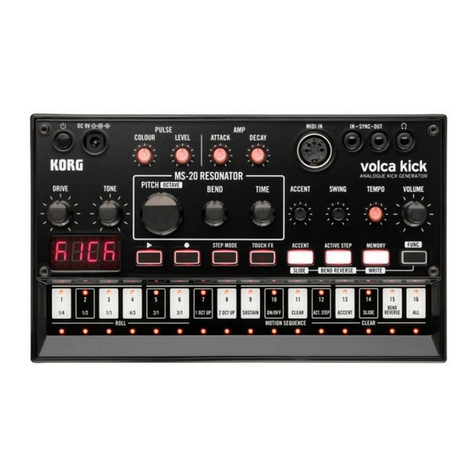
Korg
Korg volca kick User manual

Korg
Korg 800DV User manual
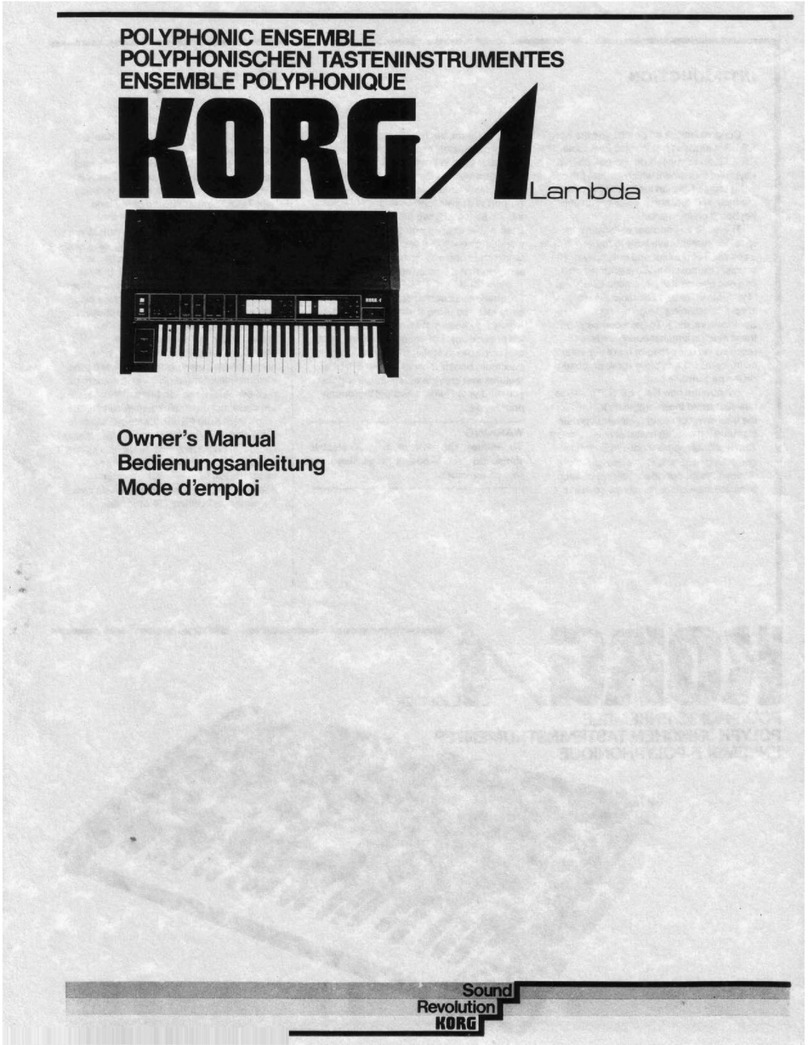
Korg
Korg ES-50 Lambda User manual
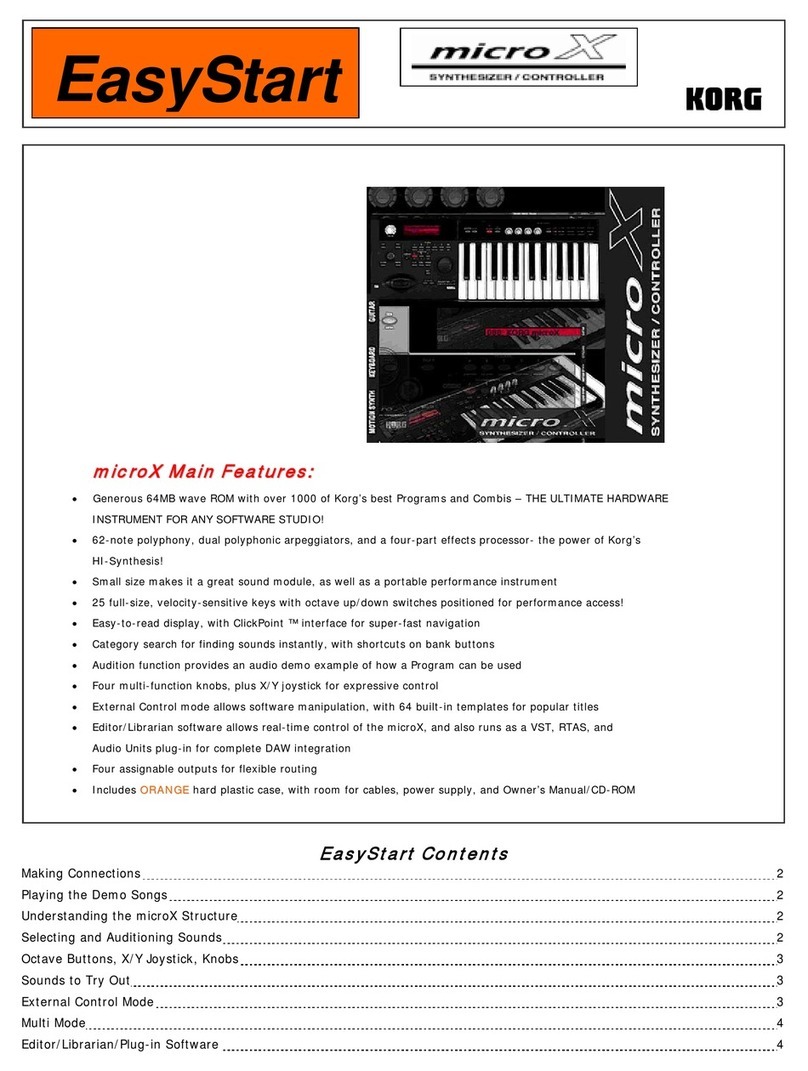
Korg
Korg MICRO X Product information sheet
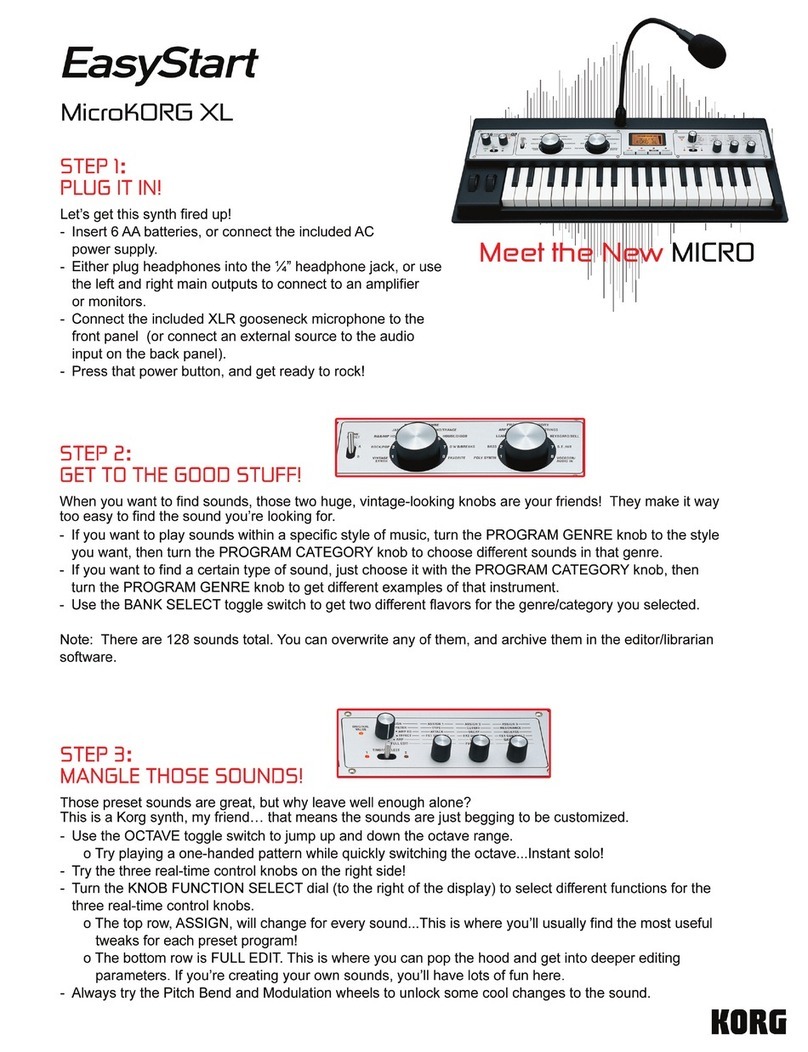
Korg
Korg MicroKORG XL Product information sheet

Korg
Korg PA 600 QT User manual

Korg
Korg wavestate User manual
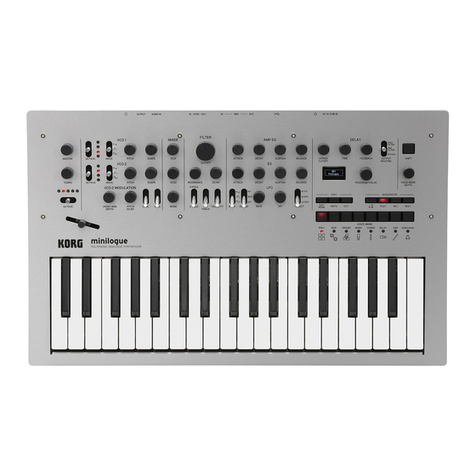
Korg
Korg minilogue User manual
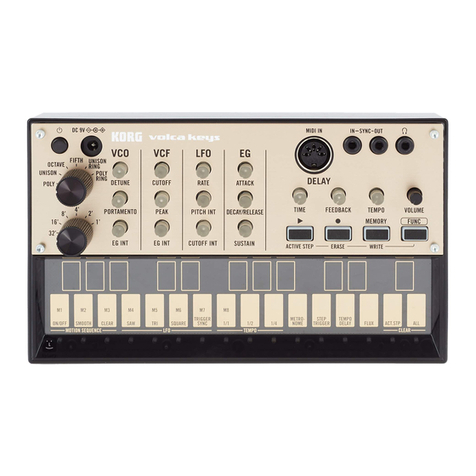
Korg
Korg Volca keys Use and care manual
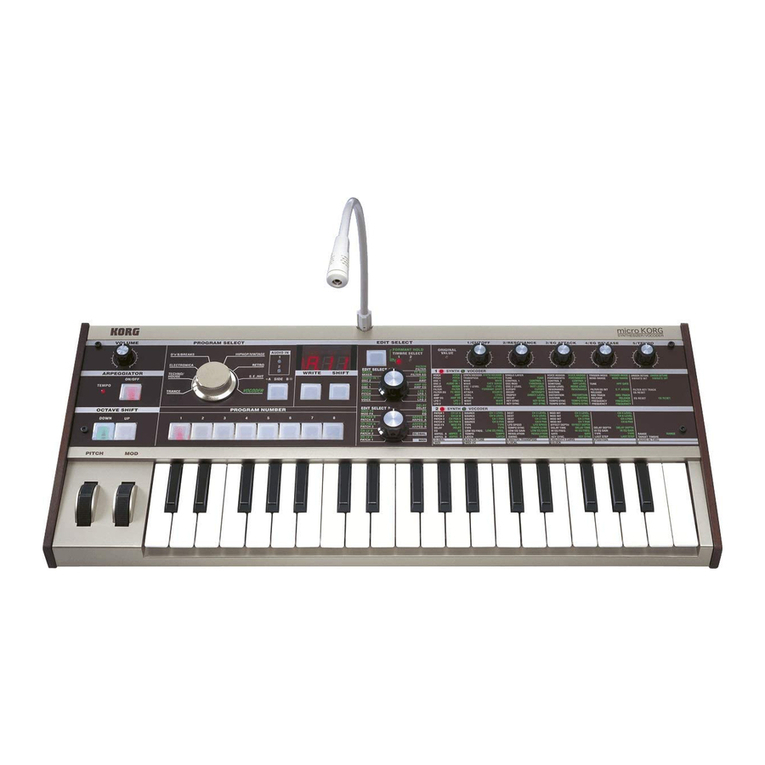
Korg
Korg Synthesizer/Vocoder microKORG User manual
